A man of a few words and emotions, slowly drawn into a deepening vortex of violence. “Drive” is a patiently woven tale of action, tension and darkness that revels in impeccably styled sets and meticulously raw drama. It is my absolute pleasure to interview the movie’s production designer Beth Mickle on how the movie came together, her most memorable sets and, how not, the story of the scorpion jacket.
Kirill: Let’s start with your background and how you got into the movie production design.
Beth: I started about ten years ago when I designed my first film when I was 21. I worked on several films with my brother when he was at film school at NYU back in 1999, and he had me working on a several student films helping out with sets, props and wardrobe. During the summer before my senior year at college a cinematographer friend of ours was planning to do a feature film; we worked together on a few films and he recommended me to be the designer. I did that – for no money – we just chipped in for the love and to get experience in feature films. That was called “Madness and Genius” with Tom Noonan, and it ended up going to the Toronto film festival, was up for Independent Spirit awards, played on the Sundance channel and did quite well for a little indie. We actually made the whole film for $18,000 (laughs).
 That was how it began for me, and I was extremely lucky that the director of that film had gone to NYU with Ryan Fleck and Anna Boden who directed “Half Nelson”. About two or three years after I had done that first film, Ryan and Anna called to see if I would be interested in doing “Half Nelson” which will forever be the film that really began my career.
That was how it began for me, and I was extremely lucky that the director of that film had gone to NYU with Ryan Fleck and Anna Boden who directed “Half Nelson”. About two or three years after I had done that first film, Ryan and Anna called to see if I would be interested in doing “Half Nelson” which will forever be the film that really began my career.
Kirill: And then you went on to progressively larger productions?
Beth: I did very small indies for most of my career, actually. That was how I was recognized, I think. And then they started to be a little bit bigger in size over the last few years until “Drive” came up. Ryan and I had stayed in touch after “Half Nelson” and they were looking for a designer and he recommended me for “Drive”. That is how I ended up on “Drive” which was another incredibly fortunate moment in my career.
Kirill: How does in general the selection process work? Do you show the stills and pictures form your previous productions, or some kind of a motion highlight collection?
Beth: It’s a mix of things. It’s almost always previous work in past films that I’ve done and people have seen, and directors and producers respond to. If I do few period films, people can see my work in that area and it can lead to jobs in other period productions. And then when I go in to actually sit down with the director I’ll bring in two things.
The first is my portfolio that has hardcopy photos of all the main sets I’ve done, and I always include “before” and “after” photos. They show the locations before we started working on them, completely empty stages or sets in a warehouse, and then after we’ve done our job to rebuild or decorate from scratch. This shows the transformations and the possibilities.
And then the other thing I bring to the interview is a book of inspiration photos that I pull together after reading the script and imagining my vision for it. I pull hundreds of reference photos for the overall tone and color, and then I pull out the top five or six sets from the script and show reference images for each one so that the director can see the direction I’m imagining for the sets.
And so we sit and I go through them all and see if the things I’m envisioning are along the lines of what the director has in mind, and it goes from there.
Kirill: How was the process for “Drive” specifically?
Beth: It all happened extremely quickly, it was a really unusual case. They were just three weeks out from shooting and they needed a designer to come in and work very quickly. So I was sitting at home on a Friday night after finishing a job a couple of days before, and I had another potential job that was going to start in few weeks that I hadn’t officially signed onto yet. I got a call from my agent, and he said there was a film with Ryan Gosling looking for a designer to come on board ASAP.
The next day I had a Skype call with the director and the producers for an hour-long interview, and that night they called and said “You have the job. Can you be on a plane to LA tomorrow?”

Kirill: So you only had three weeks before the shooting started.
Beth: Normally you have around eight to ten weeks, but it all happened so quickly that we only had three weeks from when I landed to do all the prep. This was the shortest amount of prep that I’ve ever had on a feature film; even on the tiny indies you get at least four or five weeks. But that was one of the things that Nicolas [Winding Refn, director] really responded to, he really appreciated that I was able to work very quickly under pressure to get everything done. It was very demanding. We would work 16-18 hour prep days from the minute I landed up until we started shooting. We worked over our weekends, with no days off throughout prep – and even then we didn’t have a day off until about three weeks into the shoot (Laughs).
Kirill: As I was watching the movie I noticed that you had relatively very few sets, with each scene taking much longer than in a typical action movie. On one hand you have fewer sets, but on the other you have the camera spending much more time on each one. Does that require more attention for each set?
Beth: Absolutely, and that’s a great thing to point out. We didn’t have a high volume of sets, overall we had maybe 15 total sets that we really had to focus on. And you’re right – we spent so much time on each of these sets. Even at the end in Albert Brooks‘ home where we spend perhaps 20 seconds in the scene, the original script and shooting had us there for two or three really long scenes in this huge house of his.
There was such a small number of sets. In the film I’m doing now we have over 50 sets that we’re building and dressing. And to only have 15 or 20 made the short prep a lot more feasible.
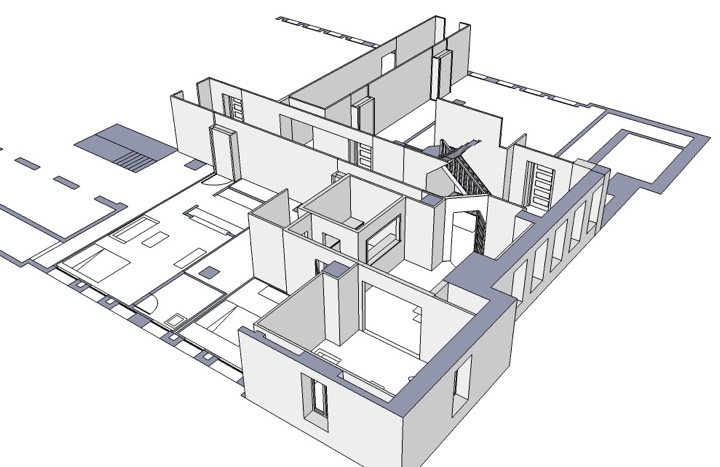
Sketch-up of driver/Irene’s apartments. Courtesy of Beth Mickle.
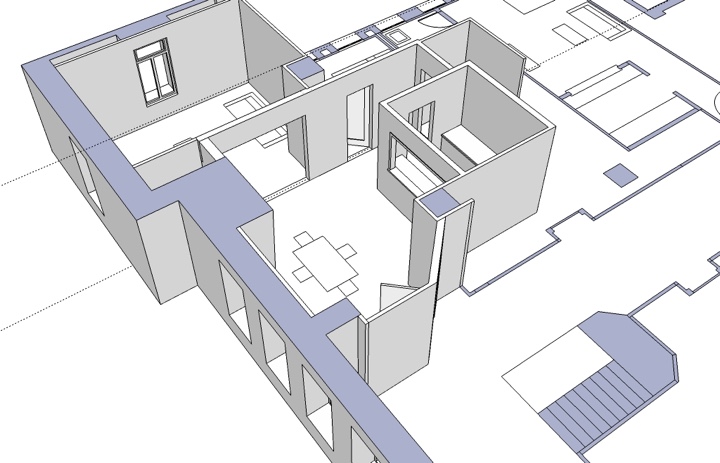
Sketch-up of Irene’s apartment. Courtesy of Beth Mickle.
Kirill: Did you have to spend much more time on each individual set because the camera ends up being there for minutes at a time?
Beth: Yes, and we ended up with a lot of detail, especially on Carey Mulligan‘s apartment and Ryan Gosling’s apartment. Those were the ones with the most focus, and both the actors were really responsive and collaborative. Ryan had a bunch of ideas for his set, and if you look at it, there’s one wall that has this kind of old toile wallpaper. We aged it to look like it had been there for several years, and it was Ryan’s idea. He said that he wanted one wall in the apartment to have an old wallpaper that has been there forever, something that you can’t explain, something that doesn’t fit his character but it had formerly been somebody else’s apartment and he didn’t bother to change or paint.
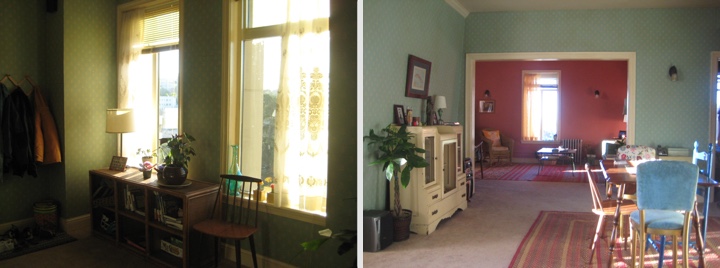
Carey / Irene apartment’s set. Courtesy of Beth Mickle.
He liked the idea that when you move into these apartments as you hop around as a nomad, you always move into somebody else’s space, into the decisions that somebody else made before you. What kind of linoleum floor to put down? What kind of carpeting? What kind of wallpaper? He wanted to play with that idea which I really liked. He also wanted to have a car engine part sitting on his table, something he’s working on it. That’s his only hobby outside of driving and listening to music in his car, and Ryan wanted to show that passion.

Kirill: Does it happen a lot that you have these conversations with actors about what they would like to see around them?
Beth: It depends. Some actors really want to be involved, and some actors are happy to let you go at it and then step in on the day to see what it is. I would say half and half. Ryan is extremely involved, and he was on “Half Nelson” as well. Probably two or three main actors on each film would want to sit down and have a conversation about their sets, bring some ideas. And the other half of the main actors are so focused on their performance and their work with the director that when it comes down to the set details, they don’t address it too much.
Kirill: Let’s talk about the car shop where Ryan’s character works. Did you use an existing location?
Beth: The space that we’ve used was the “Picture Caw Warehouse” company in LA which specializes in cars for films. They had one huge car bay out back that was empty and all white, with an office adjacent to it. We found that we wanted to shoot there, and we went in and did all the painting with rich blue tones, and did rich green tones for Bryan Cranston‘s office, and dressed everything from top to bottom. That was definitely another set with a lot of attention and a lot of details. We were there for days, and that was one of the sets that we dressed around the action – where Ryan would be working on the car, or where Ron Perlman would be walking around. We would pull the dressing around that in the background so you always see something behind them.

Bryan Cranston was really involved. He came up with a lot of ideas about what he would want to have in his office. We ended up doing a whole row of business cards lining the huge window in his office, little business cards tucked all along the frame of the window and piled up on the side of the wall. That was all from him.
Kirill: Did you do anything special with the cars?
Beth: It was so enjoyable. I went out to the vintage car lot and went through all of our options and picked the top 15 cars that we wanted to have in the background. Then we would bring them over and I would select 4 or 5 that would actually go into the car bays. We color coordinated it so that the right colors would end up there, with good rich reds, blues, greens as primaries, a few really sharp snazzy tones. Each day we would bring new cars and change them around to figure out what we want for each scene. I did learn a lot about cars, and a film that I’m doing now is a bigger action filled with lots of cars and car chases. It’s fun getting back into it.
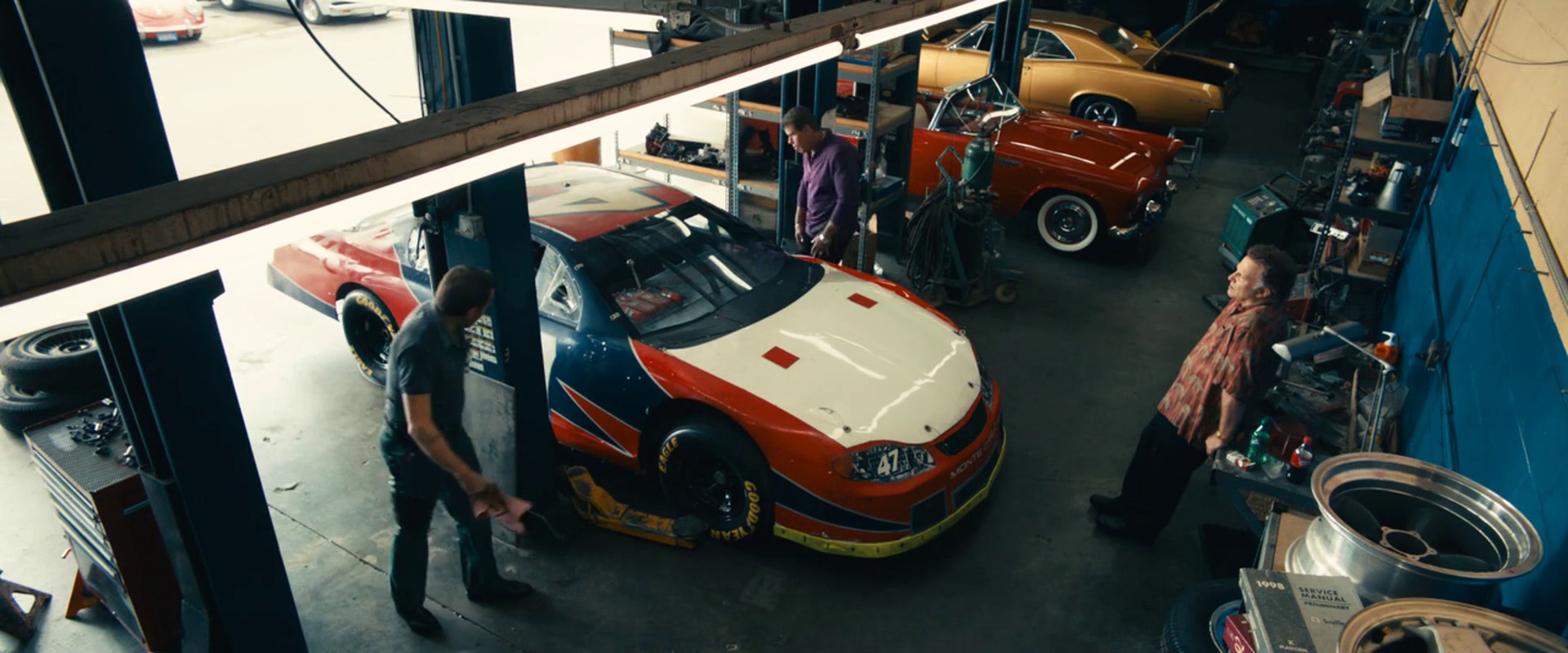
Kirill: Apart from the pawn shop and the stunt chase, most of the outside scenes are just overhead shots of the night city streets. Was this due to production constraints?
Beth: Because we were a lower budget film in the eyes of the studio we didn’t do a lot of dressing outside. The director was great. He just said “it’s all the night time with naturally existing lights in LA and let’s not worry about adding light or signage.”
Another bigger interior set we dealt with was built right downstairs from where we built Ryan and Carey’s apartments. It was the strip club dressing room with the mirrors going around in a big circle, red drapery everywhere, ornate gorgeous red carpet on the floor. We did that from scratch, set it up on an empty warehouse floor. All through the prep the Nicolas [director] kept saying that he didn’t want to see the strippers on the stage, dancing around poles as you have seen them before. He wanted to go into a more interesting space, a place where we don’t usually go as an audience. And so we came up with the idea of a behind the scenes dressing room.
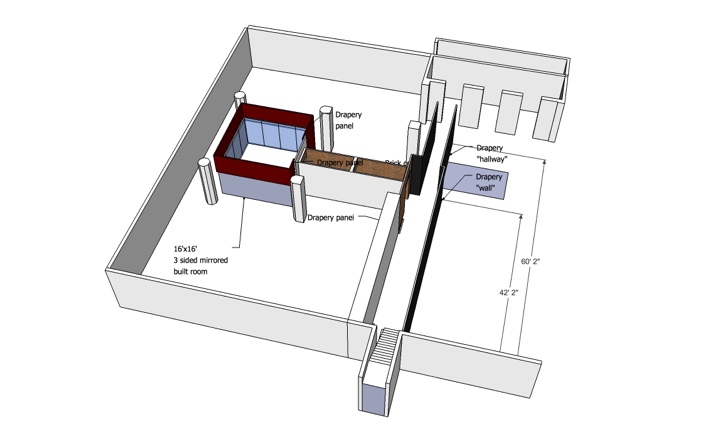
Sketch-up of strip club set. Courtesy of Beth Mickle.
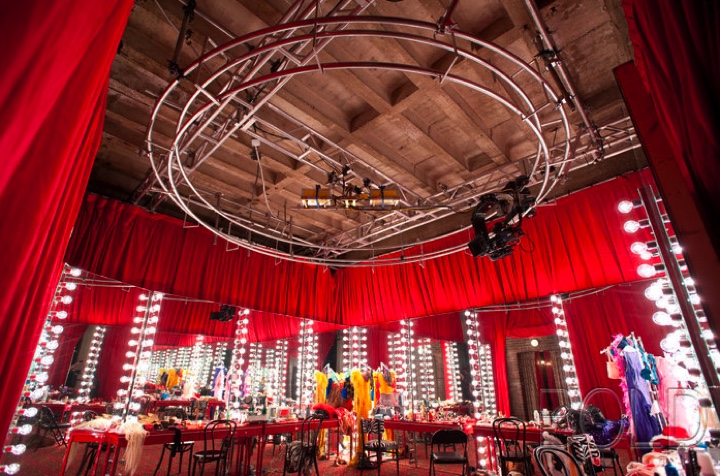
Strip club dressing room set. Courtesy of Beth Mickle.
Kirill: It was this big splash of color
Beth: That was really exciting. Nicolas said “Do something, I like mirrors, I like red drapery. Play with it”, and we had no money to do it. We ended up finding a ton of mirrors. We built them onto moveable frames and I drew it up as this big circular rim of mirrors so they would all hit each other and reflect back and forth. We couldn’t afford a ceiling so we just had red drapery hanging all across the ceiling. We found this great carpet with swirling gold and jewel shapes on it, and we used that as the ground flooring. And finally our set decorator, Lisa Sessions found these beautiful dressing lacquered tables and it all came together. We added beauty bulbs around each of the mirrors and it all became this glittering mirrored set. To this day that’s probably my favorite set in the whole movie.
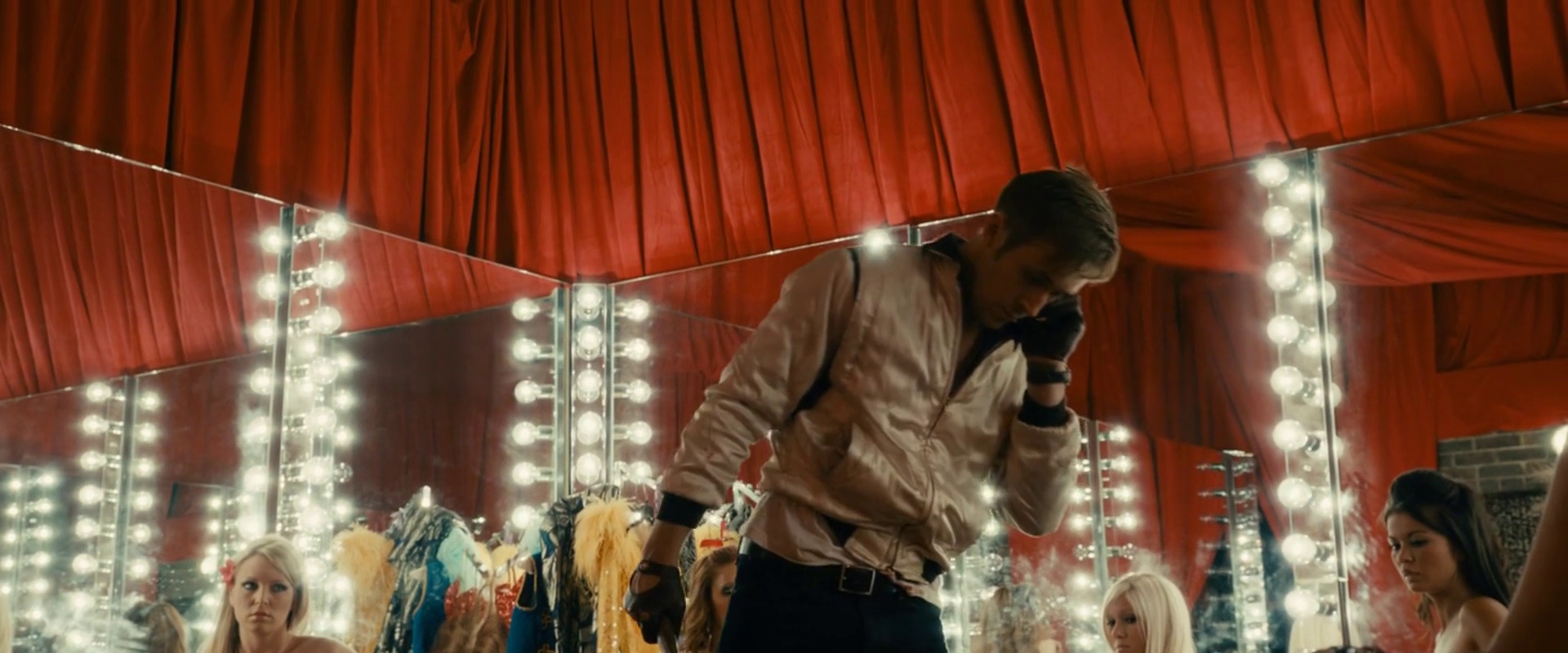

Kirill: Were you sad to tear it down once the shooting was complete?
Beth: Yes, it’s always sad to pull these sets apart as quickly as they came together.
Kirill: Even though you didn’t have a lot of external scenes in “Drive”, in general you have much less control over the external locations, especially for long shots.
Beth: Especially on smaller films. You’re part of the process when you’re picking the exterior, going out with the location manager looking to see what streets look the best, what streets have the best signage and the best layout. You’re involved with it, but on smaller films you don’t really have the budget to do a whole lot of changing there. Actually on the film I’m doing now we’re doing this Western street corner, painting the building facades, doing different signage throughout the decades everywhere, exterior lighting. It’s great when you have the resources to spread this far.
Kirill: Going back to the few outside night scenes in “Drive”, did you play with the lights to bring out certain specific areas?
Beth: That was mostly our cinematographer, Tom Sigel, and he did such a beautiful job with it. We did bring in a dozen sodium vapor street lights for the scene where Ron Perlman drowns in the ocean. We lined them along the Pacific Coast highway to provide more light for that scene.

Kirill: You already mentioned that the director wanted natural light. There were quite a few inside scenes happening in broad daylight where the outside light was let in in a very low, almost horizontally bounded pyramid. Did that affect the way you dressed up the interiors?
Beth: Not too much. We did have conversations with the cinematographer on what kind of light was he imagining to use – daylight, natural light, table lamps, standing lamps, overhead lighting. Once you know the layout of the set that definitely helps you to dress it and to think about the colors you’re going to use.
Kirill: What about the quality and spectrum of the light? Does it affect your choice of colors, textures and patterns for the set dressing?
Beth: That’s always a big thing when you’re choosing colors —you need to know what kind of lighting there will be in the room, to know which colors would work well and which won’t.
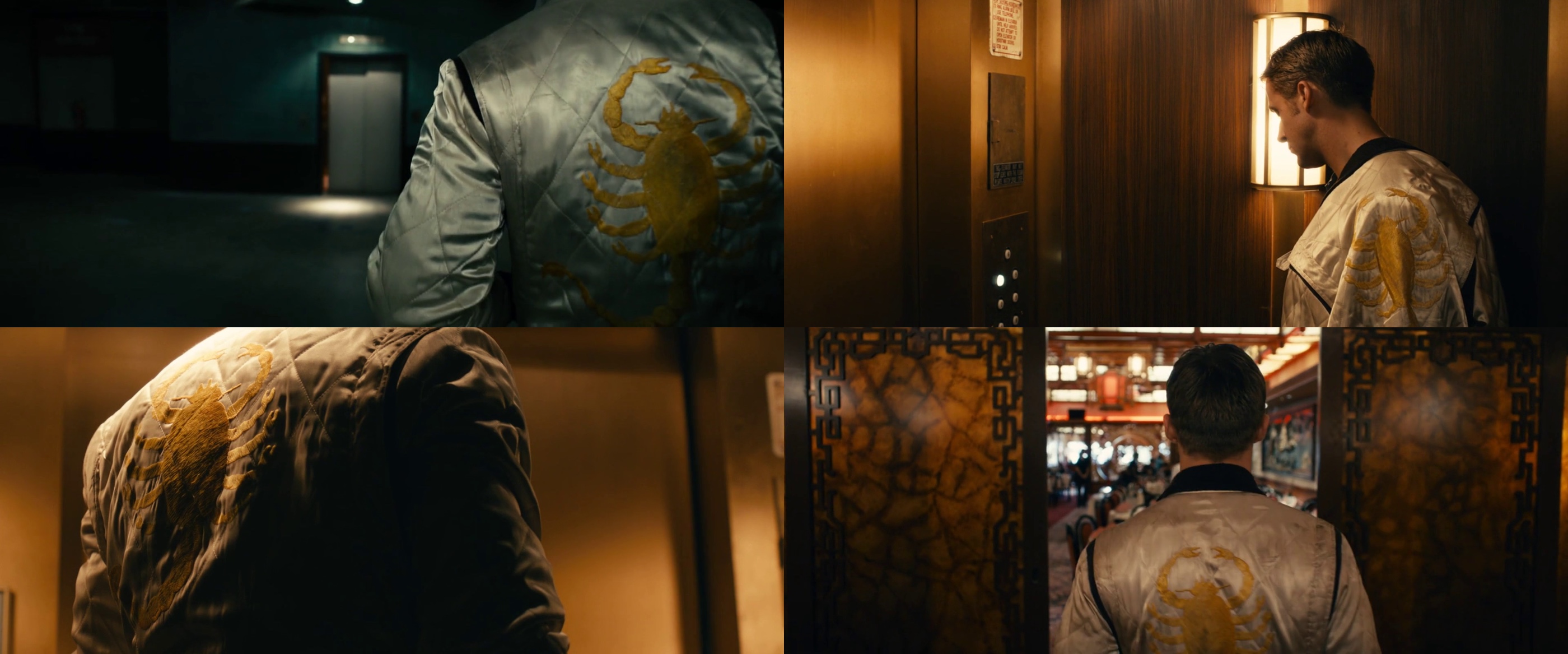
Kirill: Let’s talk about the scorpion jacket. What’s the story behind it?
Beth: None of us expected it to become such an iconic thing. It was just a fun byproduct of the film. I think that the idea came from Ryan [Gosling] and our director, but I’m not 100% certain. We knew that we wanted to have a scorpion on it, so we had the graphic designer Megan Greydanus work on the different scorpion symbols to put on the back of it. The costume designer Erin Benach worked on several different designs, tried everything – brown jackets, gray jackets, ivory jackets, aged ivory jackets with black trim, white trim. What color is the collar? What color is the cuff? We went through countless versions. We had camera tests on it, and finally we landed on the version that you see in the film. Erin did a fantastic job with it.
We wish we would have known what a recognizable item it would become. Ryan has one of the jackets, Nicolas has one of the jackets. We needed to have about six or eight of them by the end because it goes through different stages. It’s newer at first, and then it gets dirtier and then it gets bloody… then bloodier!
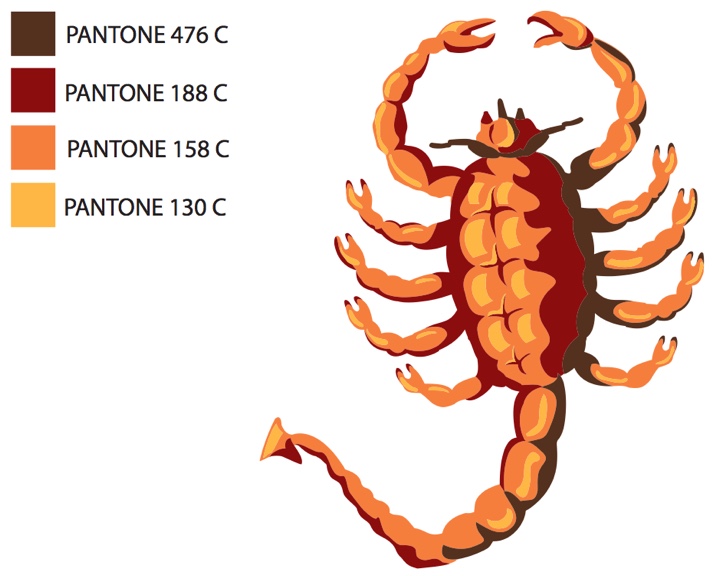
Scorpion illustration with Pantone legend. Courtesy of Beth Mickle.
Kirill: There are certain comparisons that have been drawn between “Drive” and film noir from 1940s – with low lighting throughout the movie, slanted camera angles and the overall pervasive atmosphere of doom for the main characters. Did you have any particular references?
Beth: We watched a few French films. “The Samurai” by Jean-Pierre Melville (1967) was one. We watched a few Jules Dassin‘s films, and Japanese Technicolor films. Nicolas really liked the colors in those. We watched “Irreversible” for some of the fight scenes to get sense of how he wanted the violence to go. The prep was so quick and we didn’t have a laundry list. Nicolas also wanted “Drive” to go in the theatrical direction of “Bronson”, so we kept that in mind.
Kirill: Let’s talk about Carey Mulligan’s character. Even though she essentially leads Ryan Gosling onto a doomed path, she is a very soft spoken, shy girl. Everything about her is very quiet – the fabrics, the wallpaper patterns, her hair style. Was this intentional?
Beth: Definitely. We went through lots of different options for her place. We knew we wanted her place to be a place where Ryan’s character would want to come to, a place that is warm and comfortable – versus his place which was very sparse and less inviting.
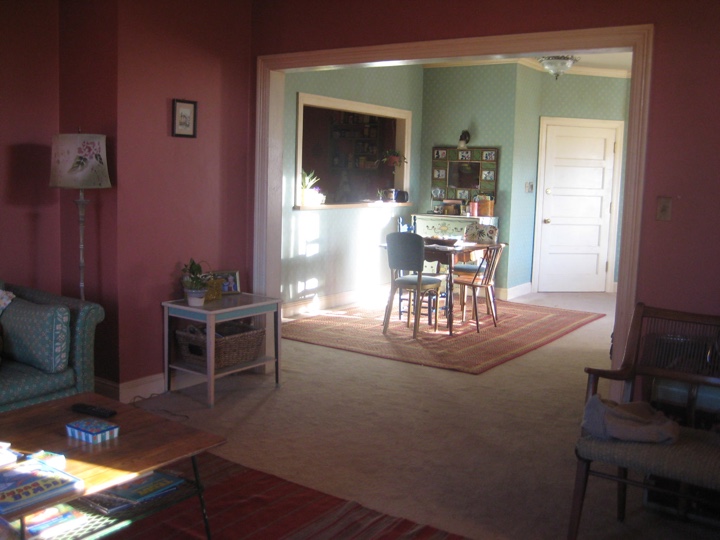
Carey / Irene apartment’s set. Courtesy of Beth Mickle.
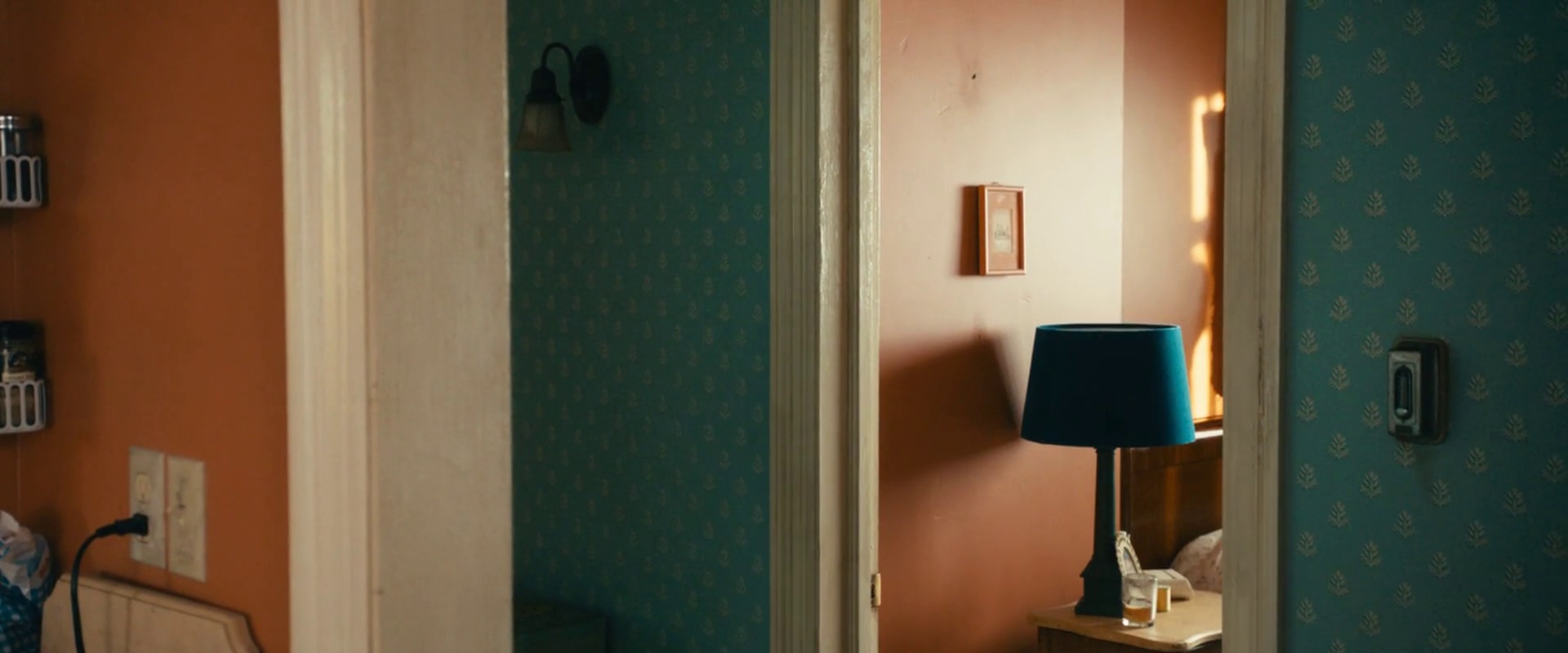
Kirill: You mentioned that the strip club was your favorite set. Was there any other set that you particularly enjoyed?
Beth: The motel room with Christina Hendricks. I was crazy about it. The location had pink walls and brown carpeting. We went in and did the pale blue wallpaper with little gold medallions all over it. And we found this beautiful bed spread with soft pink floral patterns and the same soft blue color in it, and some browns – it was a perfect complement to the wallpaper. we aged everything down to a slightly worn-in look and it ended up being this dynamite moment in the film. We added some large mirrors into the room for the DP [director of photography] to get some really interesting shots of Christina. We ended up spending so much time in that room even though it’s this tiny claustrophobic space.
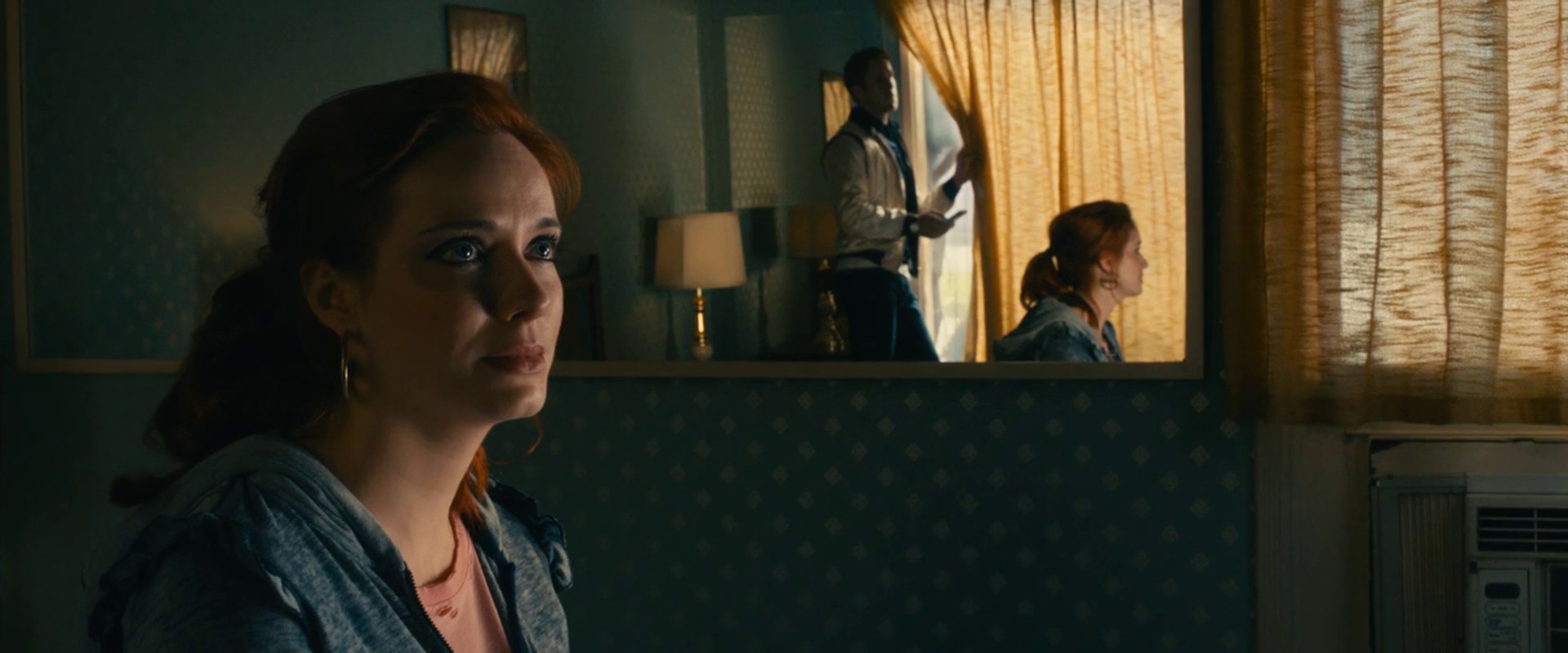

Kirill: Did you build it from scratch?
Beth: No, it was an existing motel room. We couldn’t pull the walls out like you normally can, and we had a very few windows so you couldn’t even shoot through the windows. The director and the cinematographer were both really creative in figuring how to shoot it and make it work. Then we ended up having a lot of action in there where Ryan ends up killing the two perpetrators. Just to try and get all the choreography in that little room was pretty challenging.
Kirill: Did it end up destroying the set over and over again?
Beth: We got blood splatters everywhere and we had to replace a lot of wallpaper pieces stained with blood. Between setups we would CLEAN the carpet. The set was very simple but to me it was one of the more memorable sets on “Drive”. One of the reasons why I love working with Nicolas is that he’s OK with pushing the envelope visually. He’s OK with going into a heightened direction visually, taking a few risks to play with the visuals a bit more. Some directors prefer to play it safer, to have authentic interiors and not take too much attention away from the action, to have sets that are very straightforward. Nicolas really loved to turn up the volume on each of the sets, to turn up the volume on colors. Designing for him is really exciting because you get the opportunity to pick bolder metallic wallpaper patterns and put them up, to do a set with bright red everywhere, and wild mirrors everywhere. He just loves it and wants more of it.

Kirill: But on the other hand you don’t want to overdo it.
Beth: That’s the balance. You have to find it. There are some films that go overboard and the design is screaming for attention, it dominates the frame. You don’t want it to become that, unless that’s one of the goals of the film. There are certain movies where the director does want the visuals to dominate in some scenes, and you do want it to be a more visual experience. And Nicolas is really drawn to that. The film I just did with him in Thailand is very visually driven. He wanted it to be a wild sensory experience for his audience, and so it is actually much more heightened than “Drive” was. I’m really looking forward to seeing how it comes out; we took lots of risks in it and did lots of unusual things visually. I do agree that on some films you don’t want to go too far and to take away from the story. In “Drive” we just wanted to create this sort of fantasy version of LA where these two characters meet and fall in love. That was the idea that we based everything on – that it’s actually a beautiful love story between the two characters. It’s not a story about the pawn shop robbery, it’s a story of two people falling in love.
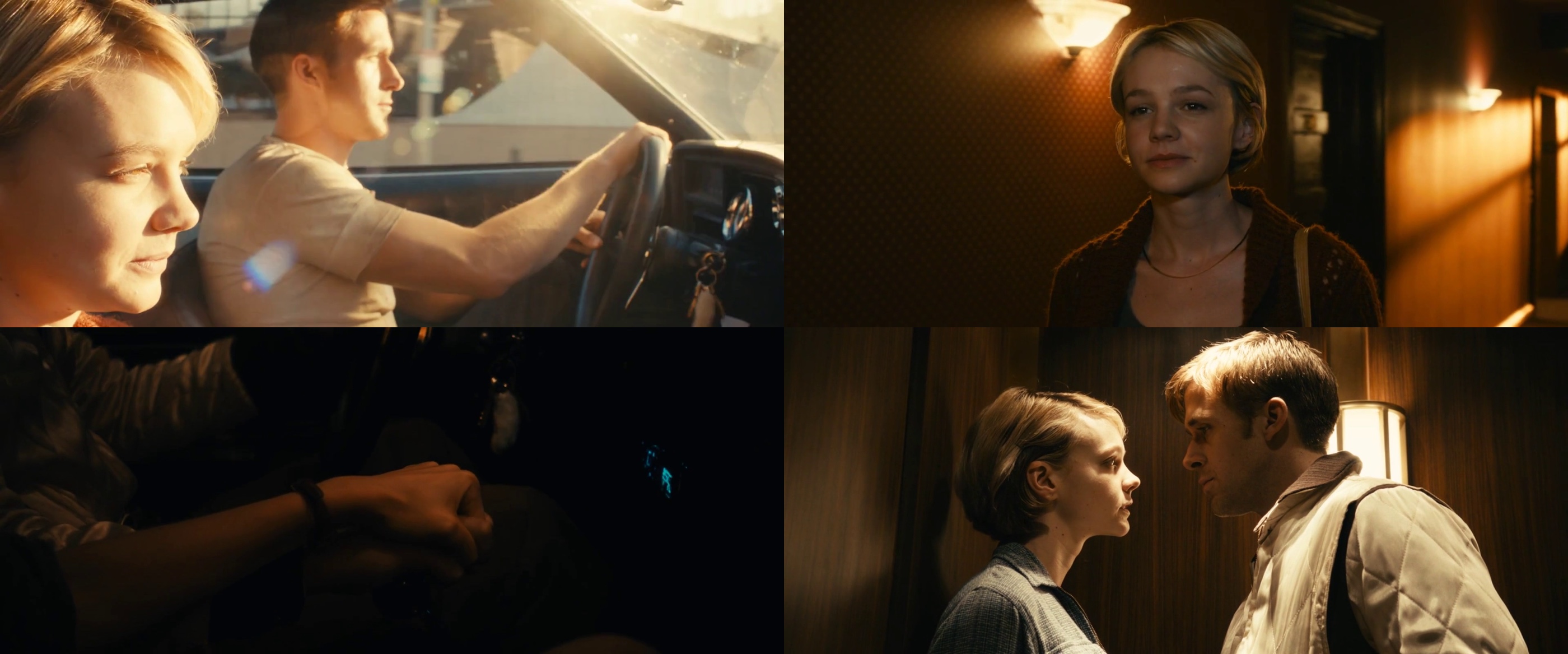
Kirill: Stepping away from “Drive” into a more general field of your craft, let’s talk about the technological progress in home entertainment. You started with smaller student and indie productions, and then moved into bigger films. About four years ago BluRay has won as the consumption format for the home entertainment systems, bringing a rather high level of details with it. Does this mean that you can’t “cut corners” anymore in your everyday work on the sets?
Beth: Absolutely. It’s one of the bigger challenges that we have to keep in mind these days as we’re doing the sets. They’re shooting digitally and the details are so much sharper. It’s a lot less forgiving. The aging on the walls has to be just right, the colors have to be just right, all the little visual details in the background and the dressing are no longer in soft focus in the distance. They are much more visible now, and that’s something that we do have to keep in mind. But on the other hand there’s this fantastic thing with digital that you have the ability to go back in post production and fix a lot of things. If you don’t like the color of something you can play with the colors in post. Or, for example, as we were bringing a lot of wallpaper pieces, if some of them don’t line up and you can see seams, you can fix this in digital post to make it go away. It has its pluses and minuses.
Kirill: What about shooting in stereo for 3D productions? Even if you haven’t done any of those, it seems to be increasingly prevalent these days.
Beth: It’s absolutely more and more prevalent. My boyfriend Russell Barnes has done three films that were shot in 3D format. I actually talk to him quite a bit about it. I’ve watched him work with it and one of the things that he’s much more aware of is that the 3D space has these visually different planes that you’re dealing with. With set dressing you end up creating different fields: the foreground, the middleground and the background. You want to make sure to have separation between them. Another important thing is the lights. The lighting for 3D is always interesting because you have to have a lot of lights to pick up all the details in the 3D format.
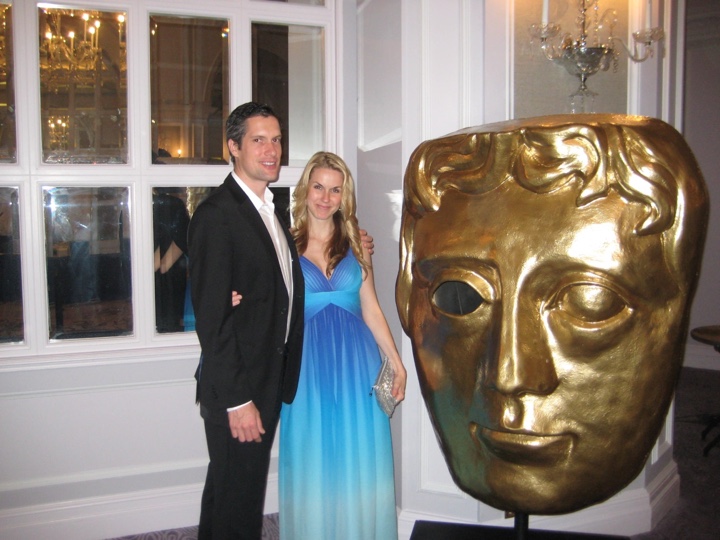
Beth Mickle and Russell Barnes at BAFTA 2010.
Kirill: Can you recommend a few productions that particularly impressed or inspired you?
Beth: One of my favorites is “Far From Heaven” with Julianne Moore. It’s one of those films that has an absolutely stunning design, well thought out and beautiful choices everywhere in it. Another one of my favorites is “All The Real Girls” by David Gordon Green — it has very authentic, naturalistic sets, feels like a true documentary.

And here I’d like to thank Beth Mickle for this wonderful opportunity to learn about the design process of “Drive” and for sharing the additional materials.
The explosively fast-paced “Colombiana” follows Zoe Saldana on a deadly mission to avenge the murder of her parents. The visual look of the movie is defined early on with earthen browns, ochre yellows and desaturated emerald greens as perfectly illustrated in this outdoors shot. Note how not only the bodyguards, but the entire house seem dwarfed by the overbearing automobile, foreshadowing the quick murder of the three men and the impending disaster for the young Cataleya.

Slightly further in the same scene Jordi Mollà‘s character tries to appear not overly menacing, as the space between him and Cataleya is lit with soft yellows of the natural daylight. However the much darker space behind his head and the positioning of his face to be to the left of the top-right rule of thirds spot hint at the sinister ulterior motive of his visit.
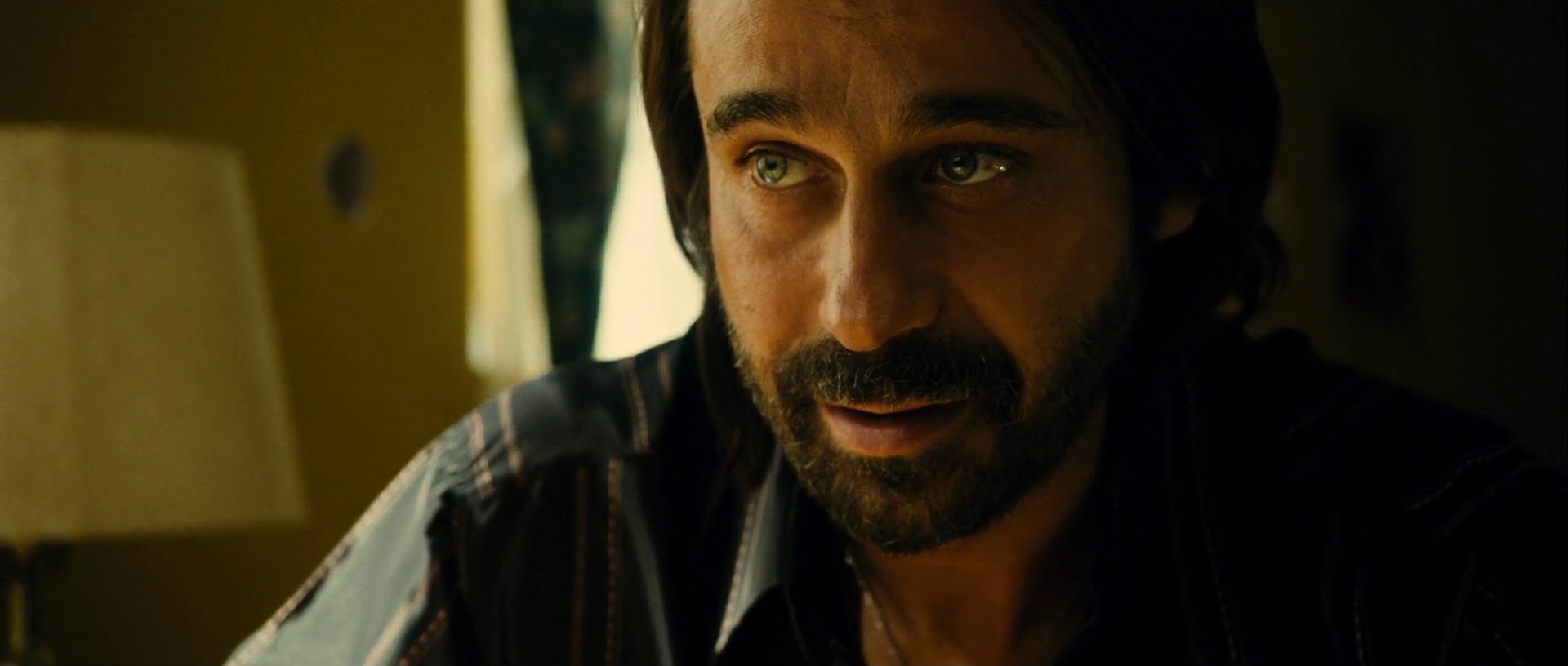
The movie jumps forward in time to see Cataleya as a cold-blooded assassin that shares time between hit jobs overseen by her uncle and exacting revenge on people connected to the murder of her parents. There’s an interesting visual connection between the establishing shots of Bogota and Chicago – similar shooting angles and color treatment suggest similarity in the corruption of law enforcement agencies and prevalence of street violence:

Most of the inner spaces involving the local police sets add chrome blue to the palette. In the left shot blue is created when the fluorescent whites bounce off of the inner metal walls of the ventilation shaft, while the right shot features extensive use of light blue on background elements:

In the next shot of a coroner examination room blue is assimilated into the green to bathe the entire set in an almost monotonous drape of washed out turquoise. The position and alignment of the camera are coupled with a wide-angle lens to distort the depth, enhancing the perceived distance along the Z axis and distancing the viewer from the police officer in charge of investigating a string of murders. Note that despite positioning the three characters directly in the middle of the frame, our eye is guided by the perspective lines towards the far right corner of the room, all the while masking the technician with a deftly placed lighting device.
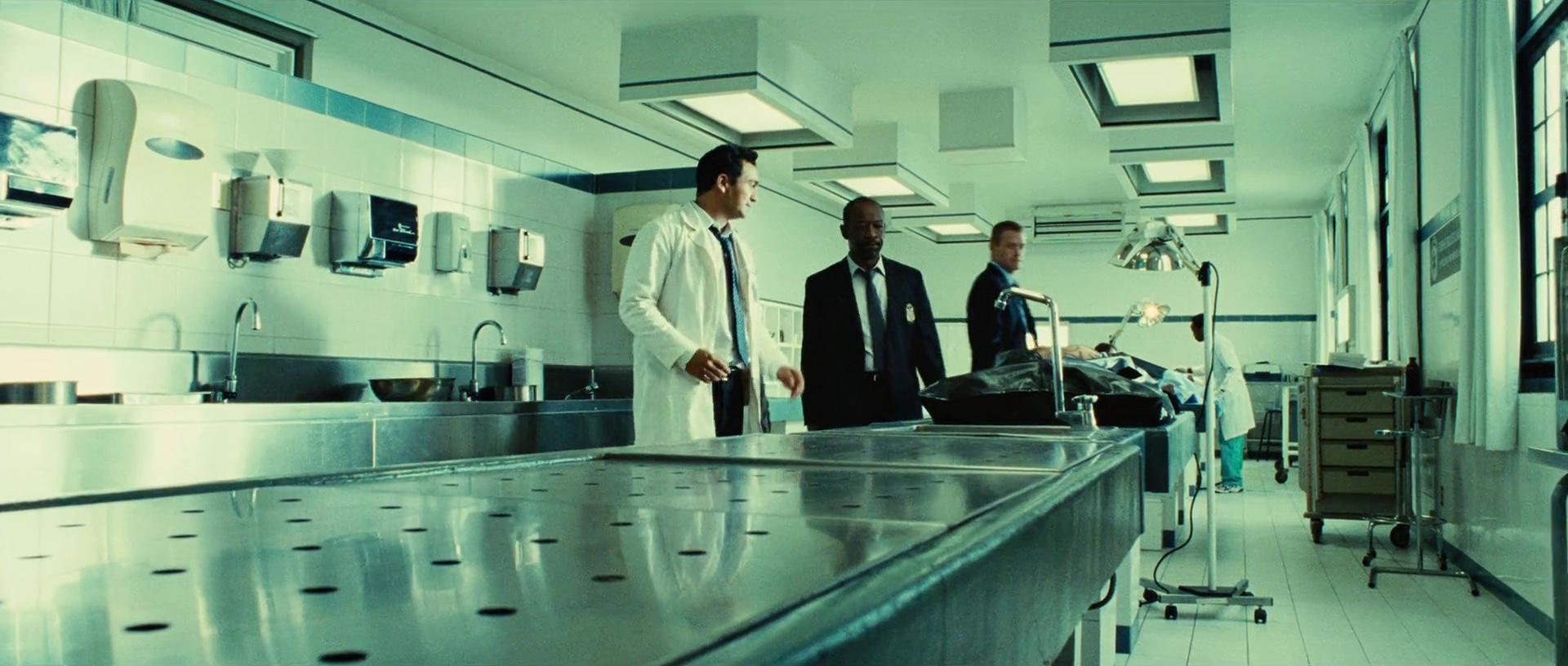
In one of my favorite sequences Cataleya goes into a book shop (or library) to be confronted by her angry uncle. The camera “welcomes” her at the door and then tracks her from behind as she makes her way across the shop floor. A fleeting cut to the bottom part of her legs reinforces her projected composure and determination:
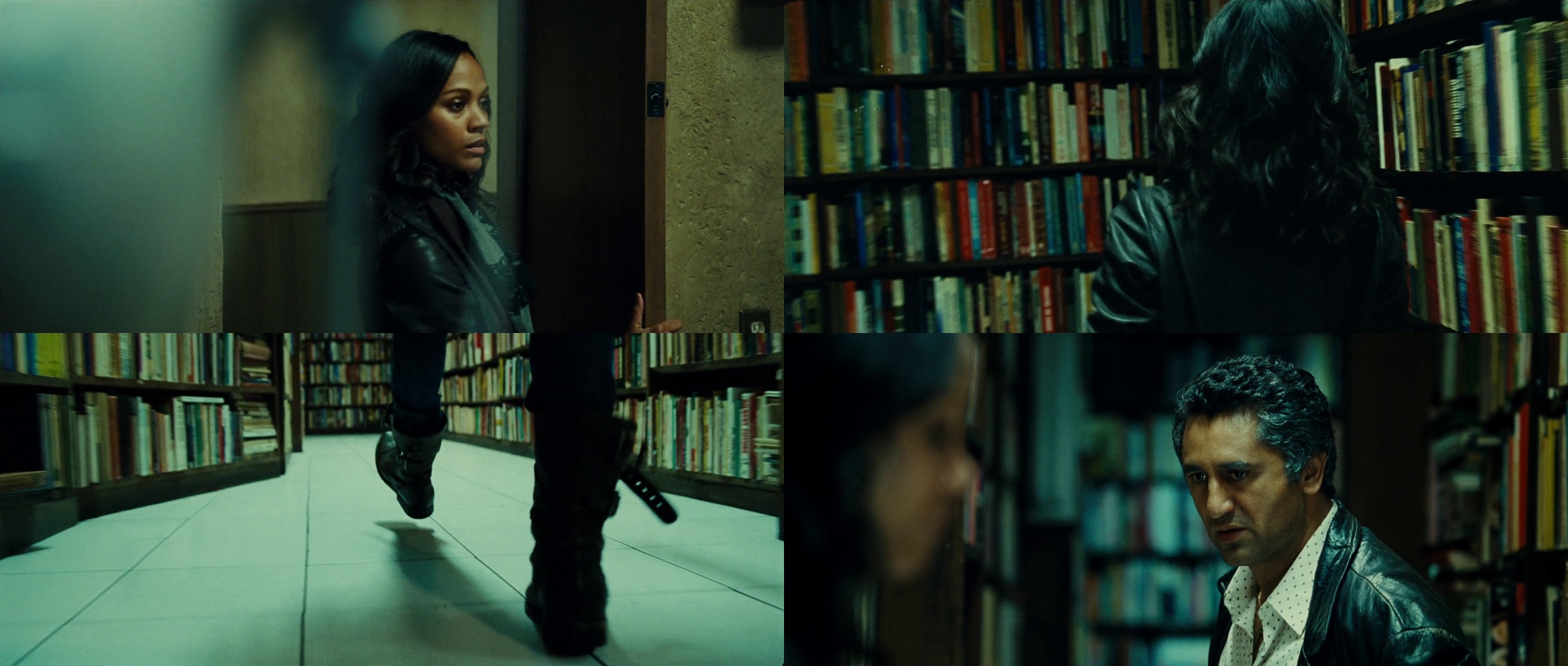
It gives me great pleasure to have Colombiana’s director of photography Romain Lacourbas answer a few questions I had about this movie.
Kirill: Tell us a little bit about yourself and your professional background
Romain: I studied art history for a couple of years in University and then joined a cinema school in Paris. Before my graduation I had the chance to be chosen as a trainee on a feature with the cinematographer Pierre Aïm. I went on to work as camera assistant, focus puller, camera operator and finally DOP [director of photography] for second unit on feature films. At the same time I was also DOP on short films, particulary with Lola Doillon. When she directed her first feature, she call me to be his DOP. It was the beginning of my DOP carrer.

Kirill: In your opinion what are the most important parts of the craft of cinematography?
Romain: Listening is the first thing you have to deal with to understand the vision of a director, and to be able to help him/her reaching the visual aspect that is going to serve the script. Finding the visual look according to the script and the director is a really important part of the work. It is also one of the most interesting and challenging parts of pre-production. Being open-minded and capable of changing what was planned, because a shooting is full of surprises, is also necessary. A good knowledge of all technical aspects (optical, lighting, grip) is also necessary to propose solutions during pre-production work as well as on the set.
Kirill: How much different it is to work on feature films, commercials and music videos?
Romain: Working on a feature film is like doing a marathon. You have to endure. Commercials and music videos are a great pool to meet young directors and they have really interesting artistic confrontation. In the meantime, due to higher budgets commercials give us a chance to test new equipment and new tools.
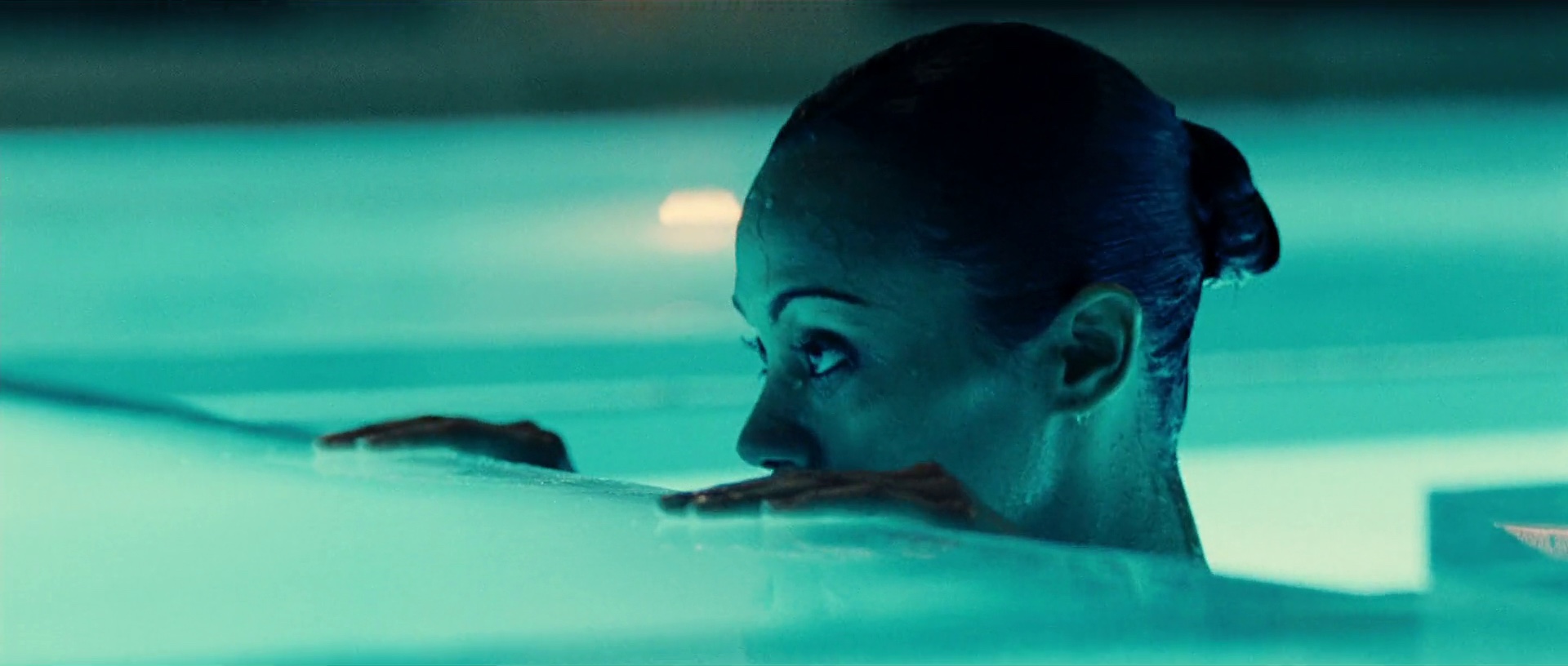
Kirill: Can you describe the process of defining the visual look of “Colombiana” before the shooting started?
Romain: Olivier Megaton (the director) and went over a lot of feature references, particularly including Tony Scott’s features. We also made different kinds of tests with different optical setups and filters in order to polish the right look.
Kirill: “Colombiana” was shot on film. What drove this choice?
Romain: Olivier and I were convinced (and we still are) that digital cameras – unless a huge post-production work is involved – can not render the same highest quality as the film. A film’s image gets instantly more body, character and texture. To reach the same goal digital tools require a bigger intervention in post-production. Moreover, in terms of logistics, such as shooting Colombiana with the rhythms, the number of cascades, and the regular presence of multi-camera setups, might have been a hindrance during the shooting.
Kirill: On a related note, what are your thoughts on shooting digital?
Romain: I think this is a great way for smaller productions which allows the director to not be concerned about the film dailies. It also opens up many possibilities in regards to special effects. This is a medium that requires a different approach and method of work (compared to the film) but which nevertheless remains really interesting and creative.
Kirill: “Colombiana” has a few well defined color palettes. Does a limited color palette affect your choice of lighting and composition?
Romain: We tried to assign colors to each place. So, there are few different colors within the same scene but one chosen tone for the set. We used relevant lighting equipment – tungsten, HMI, fluorescent lights, balloons etc – to match the desired effect.

Kirill: There are a lot of scenes involving heavy weapons. How much time was spent on set on training and safety, and how did that affect your shooting schedule?
Romain: Zoe Saldana was trained a long time before the shooting started by our gunsmith team. In addition, Christophe Maratier’s team are all seasoned professionals who are used to work on feature films. They are very fast. We never had to wait for the weapons during the shooting. Also, during the preproduction meetings we all knew exactly how we were going to shoot those sequences so that everything was well prepared upstream.
Kirill: What was the scale of construction and destruction in the New Orleans house where the final shootout took place?
Romain: The interior of the house was rebuilt on stage. By the end of the shooting it was almost all destroyed…
Kirill: The chase after the ten-year old Cataleya through the streets of Bogota was such a thrilling scene. How much time did you spend setting up, shooting and editing it?
Romain: One shooting week.
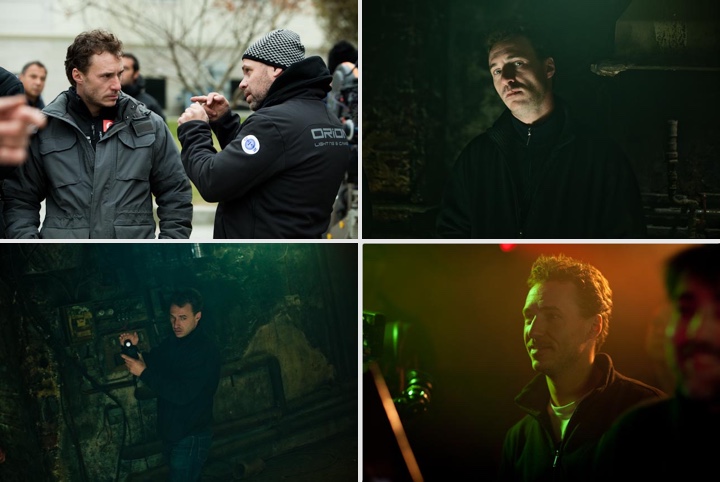
Romain Lacourbas on the set of “Colombiana”.
Kirill: Do you see your craft affected by either shooting or post-converting in 3D?
Romain: I didn’t get the chance to shoot in 3D or do post-production conversion to 3D. I would consider my work differently starting from the pre-production when that happens.
Kirill: Finally, can you recommend a few of your favorite productions that have particularly impressed you over the years?
Romain: It’s always hard to answer this question, because either you forget a lot of examples or you spend a month trying to make a precise ‘list’. But here are some features on which I found the cinematography impressing and related to the narrative aspects :
« Brooklyn’s finest » by Antoine Fuqua
« Thunderbolt and lightfoot » by Michael Cimino
« Dog day afternoon » By Sidney Lumet
« He got game » by Spike Lee
« Roads to perdition » by Sam Mendes
« Amores perros » by Alejandro Gonzales Inarritu
« Mr Nobody » by Jaco Van Dormael
« Goodfellas » by Martin Scorcese
« Little Odessa » by James Gray
« 127 hours » by Danny Boyle
« Bullhead » by Michael R. Roskam
« Bronson » by Nicolas Winding Refn
« Gerry » by Gus Van Sant
(…)

And here I would like to thank Romain Lacourbas for finding time in his busy schedule shooting “Taken 2” and for graciously agreeing to this interview.
Distilling the art of film making to its purest form of visual storytelling, “The Artist” is a breathtaking masterpiece of cinematography. A story set in the glamorous days of early Hollywood, it effortlessly transports the viewer into the meticulously recreated world of silent black-and-white film. An authentic, warm and enchanting journey combined with a universal story of fame, pride, fortune and affection brings one of the most remarkable films in the recent history. The weeks leading to the Oscars awards ceremony are a very hectic time for Laurence Bennett, the production designer of the film, and it is a great honor to interview him about his work on “The Artist”.
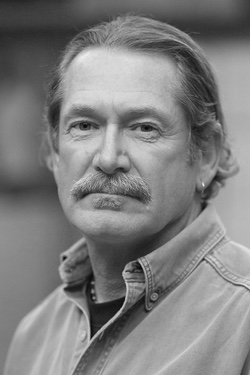
Laurence Bennett.
Photography by Jamie Trueblood.
Kirill: Let’s start with your background. You worked outside the movie industry for about ten years, and then moved to work on TV and movie productions.
Laurence: I started working in design when I was quite young. Between the school and college I worked in a small design firm. I studied in Los Angeles and in Japan, and after finishing college I moved to Ireland for ten years. I worked in theater and taught in the National College of Art. I was a painter and working in theater was really my introduction to show business. In the mid-seventies I had friends from Los Angeles who were getting into film business, and one summer I came back and worked with them doing miniature models for a big television special. That was my introduction to Hollywood, and interestingly, the production office we had on a small side street for “The Artist” was right across the street from the place where I worked 35 years earlier.
Kirill: In the last few years you worked on action thrillers such as “In the Valley of Elah”, “One Missed Call”, “Traitor” and “The Next Three Days”. How did you get to work on “The Artist”?
Laurence: It was sheer luck. One of my agents called me and connected me with the line producer who was assembling crew for Michel Hazanavicius [director]. We met, talked and hit it off, and I went to Los Angeles to meet Michel. The next morning we were out scouting together working on the picture.
Kirill: Did you have any hesitations joining such an unusual production?
Laurence: I embraced it whole-heartedly. I was very excited.
Kirill: Were you particularly connected to the 1920-30s era before you’ve started working on this film?
Laurence: I’d always been a fan of the movies of the era. My knowledge wasn’t as deep or as broad as it is now, because of all those months I’ve spent living and working in the period with Michel, Guillaume [Schiffman, cinematographer] and all my friends. There’s real magic in the pictures that came out of Hollywood in those early days. They were inventing the language of the cinema, and at the same time inventing the business of Hollywood. They seemed to have had a great time doing it, so I encouraged my crew to take on the same spirit of fun in approaching this project.
Kirill: Can you describe what happened during the pre-production stage, as you were working with Michel and Guillaume on the overall story and look, and the particular scenes?
Laurence: Michel arrived with the entire story boarded. His vision for the project was so complete and so whole. He had very specific ideas for most of the shots. The trick for me was trying to build the world around these shots that the characters would live in. We spent a good two and a half months in pre-production. We watched dozens and dozens and dozens of movies together. Michel introduced me to the works of F.W. Murnau, King Vidor, Fritz Lang and Josef von Sternberg. Also in Los Angeles there’s always an opportunity to see restorations of older works. Mark Bridges the costumer and I went to see the new restoration of “The Four Horsemen of the Apocalypse” [1921] which was Rudolph Valentino‘s big breakthrough film. And when you see good cinematography and design from the period that’s well restored and printed, the photography is so remarkably beautiful. Really exceptional stuff.
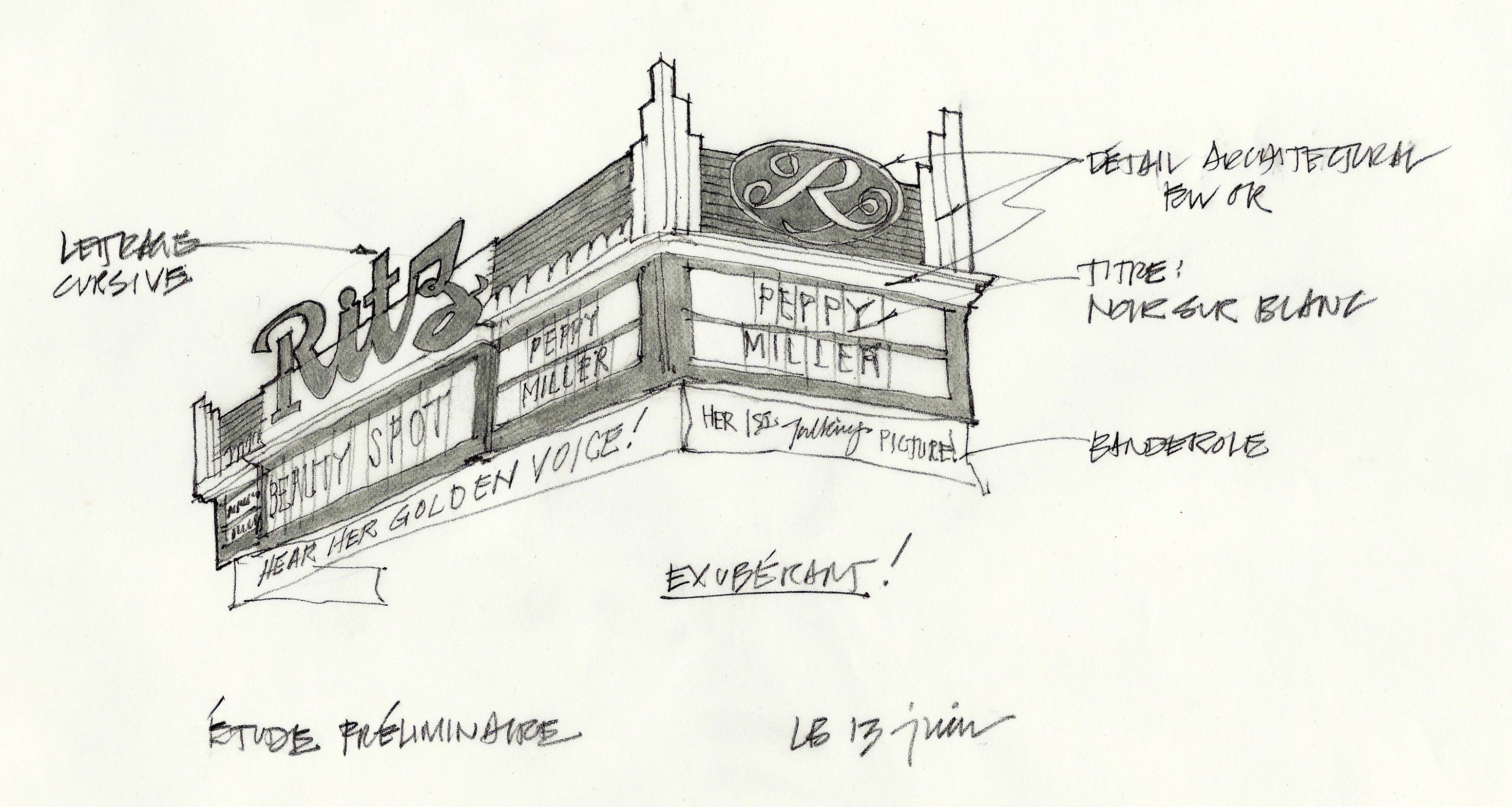
“Ritz” theatre marquee. Sketch by Laurence Bennett.
Kirill: Michel and Guillaume worked together before. How did you get into the rhythm of working with them?
Laurence: They are also very close friends. They were very welcoming to me into the process. It was great, the pre-production was absolutely delightful. It was time of shared exploration, kicking ideas around and finding things, seeing what would work.
Kirill: Were you aiming to limit your setups and techniques to what would be available to production designers and art directors of that time?
Laurence: Very much. There’s a directness and simplicity and real grace around the art direction of the time. I tried to mimic that. One thing was very important to us – the supremacy of the story. We were telling the story of George and Peppy and Jack the dog. Nothing was ever to upstage them, nothing was ever to get in the way, they were always center and clear in the story telling. I felt a real responsibility to make these living breathing environments that they operated in to never be a distraction, and to always support the believability of their situations.
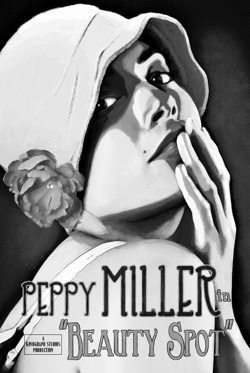
Artwork: Beauty Spot Poster.
Graphic designer – Martin Charles.
Kirill: Did you research the specific setup techniques of the era, along with the additional materials like fabrics?
Laurence: It’s all terribly important. Fortunately I had a team of very talented people, between my set decorator Bob Gould and the prop master Michelle Spears. They researched and put together many of these things to look at. Guillaume, Michel and I did extensive camera tests for materials, paint, pattern, make-up and costume. Testing in the various art departments went on right through the photography. Whenever we were putting together a palette of materials and textures and finishes for a particular set, we would test them in black-and-white.
Kirill: “The Artist” is your first production without color. Having such an important tool removed from your fingers, did you spend more time on contrast, textures and light to compensate for the lack of color?
Laurence: Certainly I focused a lot more on texture and pattern that I ever have before. Even the luster of finishes, the shine or the lack of shine. Without chroma cue for separating things within the frame you have to rely a lot more on rim light and contrast of light and shadow. I really found pattern and solids and different textures to be a great way to differentiate planes within a frame.
Kirill: Did you remove the color from the actual sets?
Laurence: I decided on an approach that was rather split. Because there’s so much film work within the film, with all the studio sets and the movies that we see in the movie, I decided to do all of those in black-and-white. The naturalistic sets within the story were rendered in naturalistic tones.
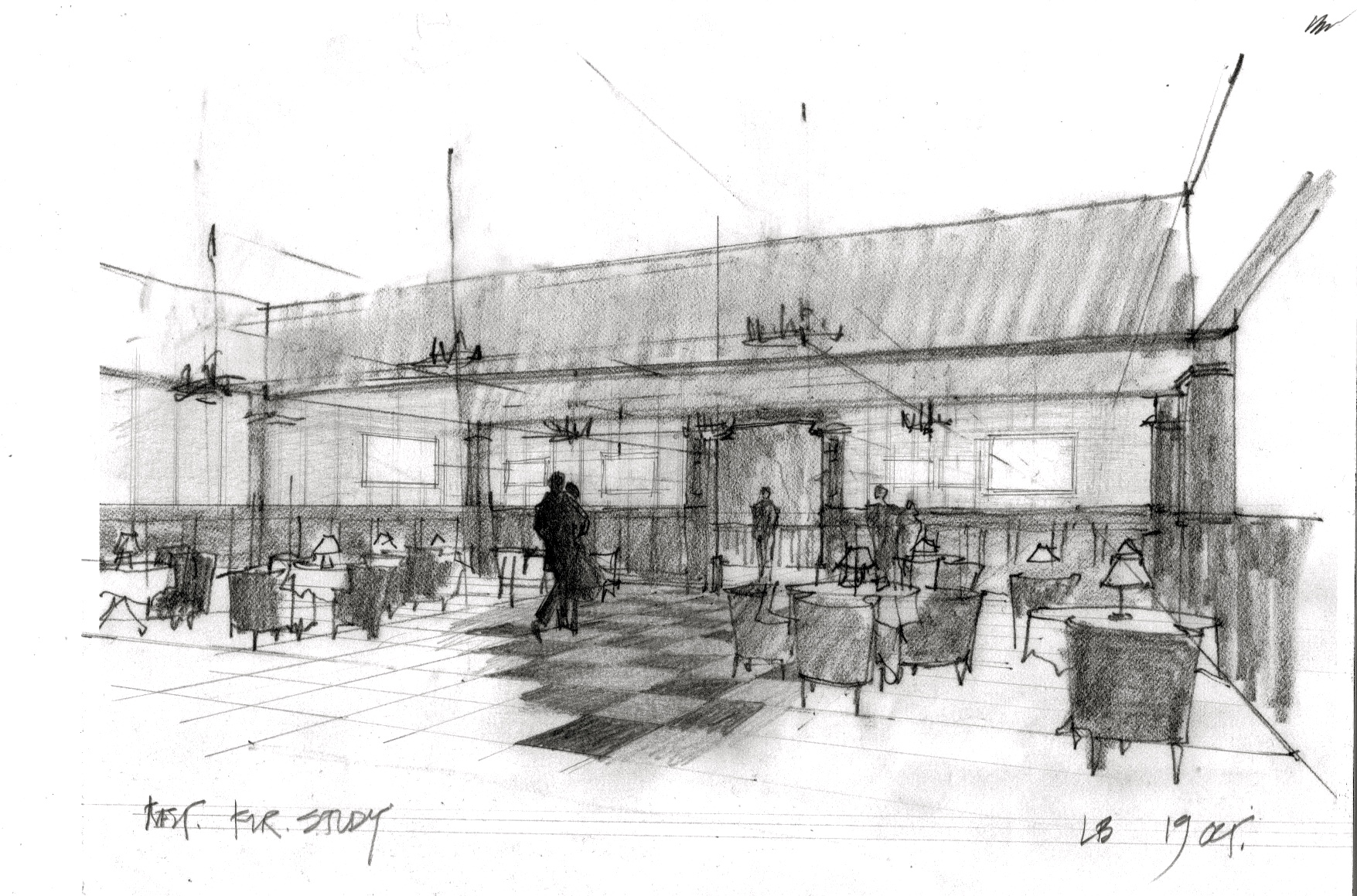
Restaurant set. Sketch by Laurence Bennett.
Kirill: And then you have another aspect of the era, shooting in the Academy ratio of 1.33:1, with much less horizontal space. How did that affect the preparation and setups when the audience sees less?
Laurence: You see different things. I’ve done 1.85:1, and most of my recent work has been 2.35:1. In 1.33:1 you see a lot of ceilings and floors, whereas you don’t in 2.35:1. So the composition would have a lot more above and below. It’s a different way of looking, a rather more awkward framing, and it’s difficult to adjust to. All of the location photographs, all of the sketches that I’ve prepared for Michel – everything was presented in 1.33:1 so that we would get used to that format.
I spent a lot more attention to the floors particularly. One of the things that was typical of the film sets of the time was that they seldom had ceilings. We had some ceiling pieces, elements and headers, but floors were a larger concern.
Kirill: Did you build your sets in the studio stages?
Laurence: It’s a big mixture. We had many many locations, all of the historic locations of the period – Peppy’s house, George’s mansion, the theaters. We did a lot of work on the back lots at Paramount – Los Angeles streets, the pawn shop, the tuxedo shop, George walking around, a little bit of the driving stuff, Peppy on the bus. Other driving stuff was done in an old Los Angeles neighborhood. The exteriors of the theaters were done at the Warner Bros back lot. And everything else was done on stage – George’s apartment after his fall, the screening room, the jungle, all of the little sets you see within the movies. We had a tremendous number of stage sets.

Magazine cover of “Screenland”. Graphic designer – Martin Charles.
Kirill: What happened to those sets? Are they gone, and was it hard to see them demolished?
Laurence: That’s what always happens. You hope that pieces would be recycled in other things. We used only painted backdrops outside the sets, and I tried whenever possible to use the oldest black-and-white ones. There are only very few still available, but there was one in particular that spoke to me. There’s a movie that Peppy does within the movie, “Guardian Angel”, and it has a North African, Moroccan feeling. The backing outside that set was from “Casablanca” [Humphrey Bogart, Ingrid Bergman, 1942]. And when I found that, it was a very rare and wonderful thing, like unrolling a holy relic. It was painted in black-and-white in the early 1940s. It was a real honor and thrill to be able to use it.
Kirill: You mentioned one of the historic location used for Peppy’s house. This is the old Mary Pickford residence. What is it used for these days?
Laurence: It’s a residence. A family owns it, and they recently did a major restoration. It’s in a beautiful shape. We looked at it and fell in love with it, and only then realized its provenance. When George wakes up from his convalescence in Peppy’s guest bedroom – that was Mary Pickford’s bedroom in the few years when she was seeing Douglas Fairbanks before they got married. It’s pretty remarkable.
Kirill: Was access to all the historic locations one of the main reasons to shoot in Los Angeles and not Europe?
Laurence: There was another reason. Michel and Thomas Langmann the producer had a very strong feeling about making the story in Hollywood because the story itself is about Hollywood – and I loved them for that.
Kirill: There was this odd piece floating around about a UK theater issuing refunds to people who didn’t know that it was supposed to be a silent film. On one hand, the story becomes more accessible when you remove the sound, but on the other hand, do you feel that the modern audience is ready to see such a movie?
Laurence: I think those stories are very exaggerated. It seems to have been one cinema in some place in the UK. I would hope that the picture opened up to a much broader audience the incredible strengths of a pure version of visual storytelling. Cinema is first and foremost a visual medium. I would hope that it’s exposed people to broaden their horizons a bit. The universality of the story by lack of dialog is quite incredible. I only realized it the other morning as I was doing a radio interview with a journalist in Bogota, Colombia, and there were journalists from Spanish-speaking world in four different countries asking questions. It was an incredibly emotional experience seeing people moved by the picture, hearing people’s questions and reactions from around the world.
Kirill: Even as the sets are in the background and the main focus is on the characters does not mean that you have less work to do.
Laurence: It’s a collaborative art form and I never worked on a production where both the cooperation and collaboration between various art departments was as strong and joyous as it was on this picture. Also, because of the uniqueness of the approach to storytelling I think it was much more essential that we worked in sync. This picture is nothing without what I think to be a good solid cinematography, design, costumes, make-up and hair. The casting is phenomenal, the extras casting – everything that was done by all the departments was so strong that it supported a very strong picture.
Kirill: The movie itself covers a roughly five year period, from 1927 to 1932, with the Great Depression striking right at the middle point. If you just watch the movies from the era, the glamour did not go away; in “The Artist” there’s a certain transition as George goes broke, with much less glamour surrounding him. How did you alter the visual language throughout the story?
Laurence: And then you notice as he’s pulled back to life by Peppy’s faith in him, the movie ends with a glorious, very high style finale, as he returns to a very glossy career. It was obviously by intent that the picture is taking a dark, slightly expressionist turn. His crisis was an opportunity to really darken the story and let the threat and his conflict be demonstrated visually in a different way.
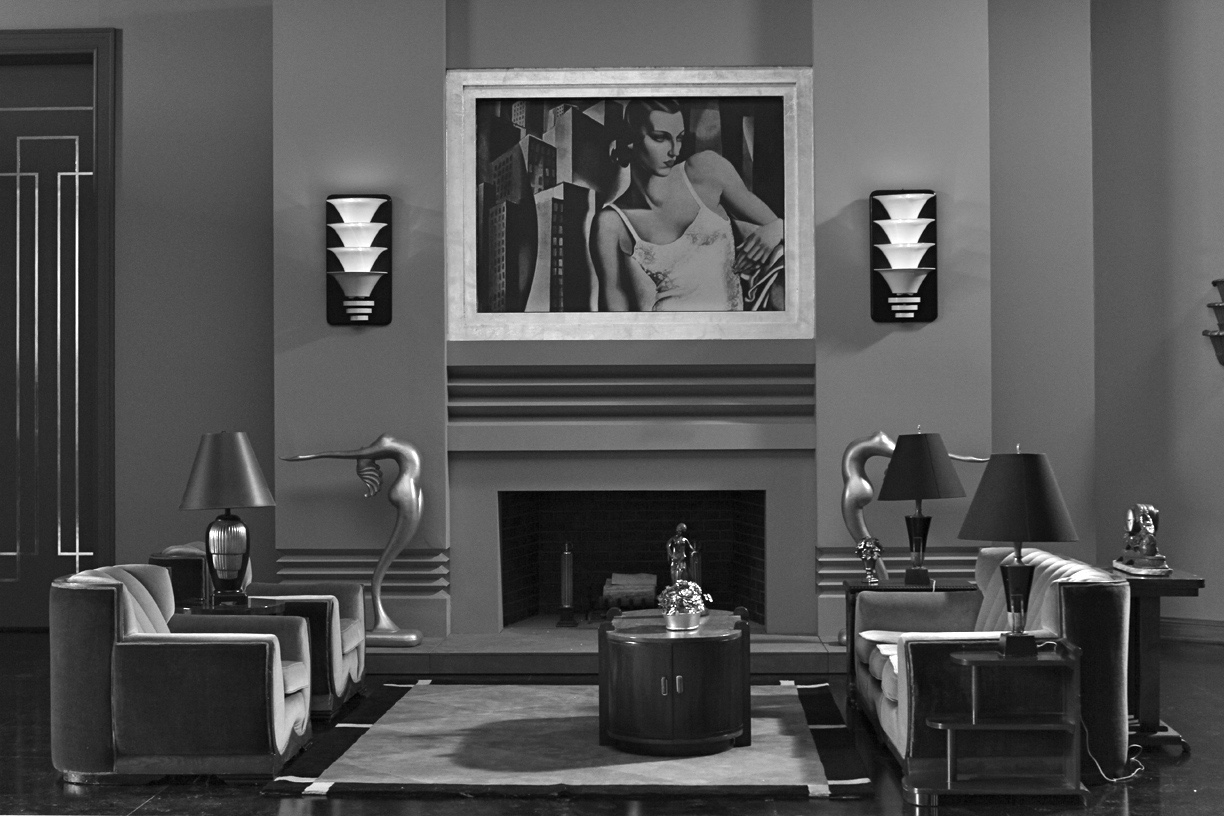
Still picture of one of Peppy’s 1931 movies. Photography by Peter Iovino.
Kirill: Do you notice any significant difference in the visual look of the movies from 1930s as they switched to sound?
Laurence: Last week I was actually watching a few pictures from the very early 1930s. Cedric Gibbons, the production designer who is best known from that period, was responsible for not only changing the look of the Hollywood product, but also influenced interior design and product design around the world. He was responsible, more than anyone I can think of, for popularizing deco. He had been to the exposition in Paris in 1925, and he returned to Hollywood with this incredible enthusiasm for the modernism, the modern hope that its flair personified to him, and he began putting that into the scenery.
There’s one set that’s very influenced by Gibbons in “The Artist”. The set where Peppy is filming when she receives news of George’s accident when she reads the newspaper – it’s derived very directly from a set that Gibbons used both in “Our Dancing Daughters” and “Our Modern Maidens”.
Kirill: You mentioned the scene where Peppy is riding on the bus. There’s a few dozen other cars in the movie. Can you talk about the logistics of getting access to all these vehicles?
Laurence: They are real vehicles, and it’s tremendously difficult. The picture vehicle people worked long and hard to secure those cars and trucks and buses. There’s an amount of very common ones available in Hollywood, but for very special ones you need to go to the collectors. The bus was particularly hard to come by. We used the vehicles as is with no modifications, but the search for a couple of them was particularly prolonged and difficult.
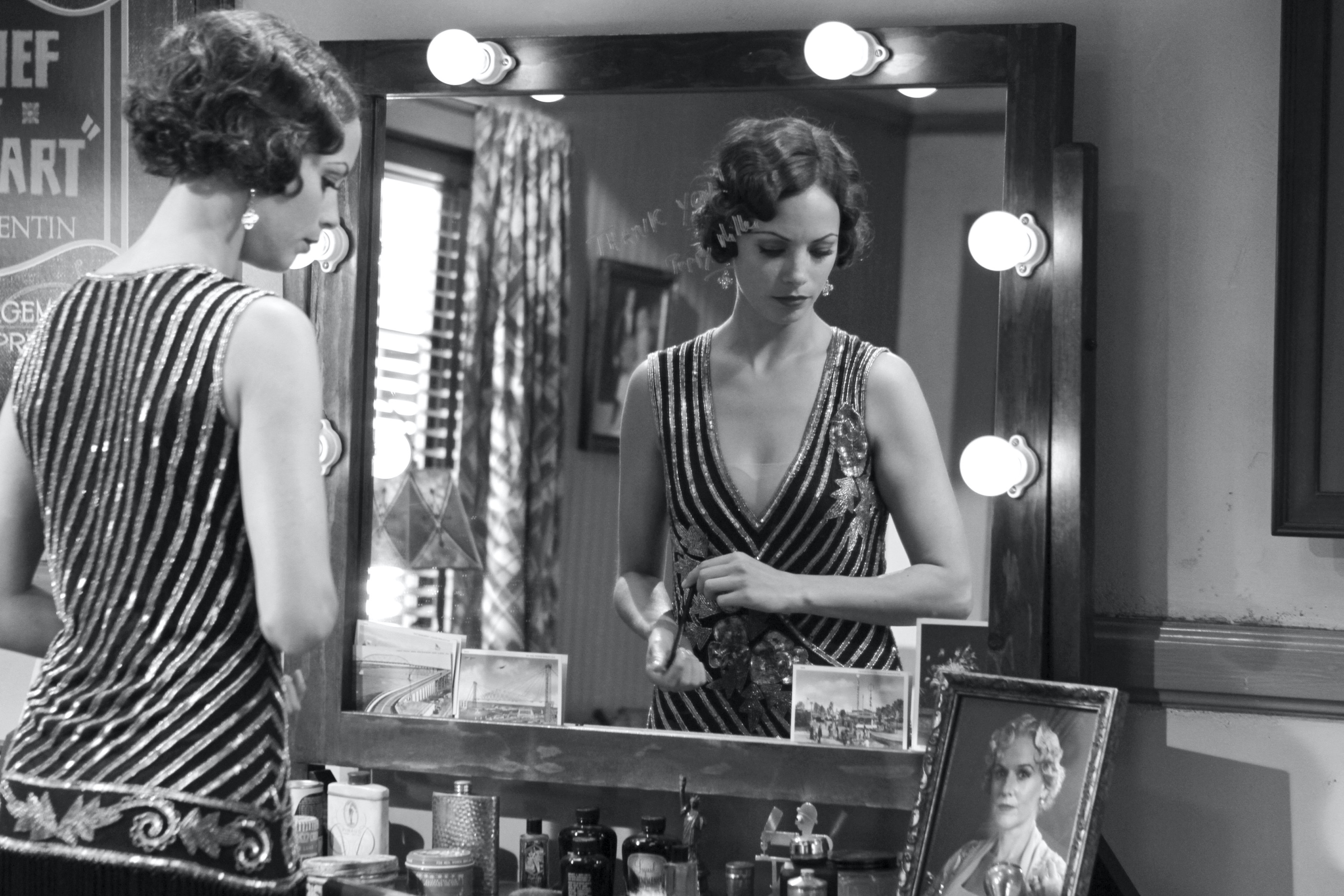
Kirill: Does that authenticity extend to the lower level of details of accessories such as microphones, hair brushes or light bulbs?
Laurence: We decided early on that we wanted to be true to the spirit of the period, rather than being slavish to detail. But certainly everything is quite authentic, requiring a little bit of looking and thinking. It also depends. The light bulbs, for example, are reproduction bulbs. But the sockets are from the period. We custom-made George’s table, but other items such as dressers and make-up tables were readily available.
Kirill: How much time and attention did you spend on the costume design? Was it a separate mini-production of its own?
Laurence: That was all Mark Bridges the costume designer who is a genius, and I think he has a lot of very deserved attention to this picture. There is a good bit of period wardrobes still available, but the problem is that it’s not in a very good condition. It falls apart as fabric deteriorates over time, so he built a lot of things. A lot of Peppy’s dresses, for example, were built from the styles of the time. He did a brilliant job saying a lot about the characters’ progressions through their arcs, but also helping bring them to the right amount of attention within the frame at any given time. Things like white colors on Peppy’s dresses and hats really bring attention to her face and focus her even in a crowd. Between lighting and costumes a lot was done that really highlights the characters.
Kirill: You’re recreating a very glamorous era in Hollywood’s history, but also an era that has the vast majority of its films well preserved (unlike the early movies that have been largely lost). Were you trying to avoid comparisons to any specific real-life actors, or was it a mixture of original storylines and homages?
Laurence: George Valentin begins as Douglas Fairbanks, morphs into John Gilbert and then becomes Fred Astaire. We were trying to be nimble in how we portrayed the characters and allowed them to grow a bit. There are obviously certain studios and stars and products from the time that were very much on our mind, but it was also important that we’re not too tied to any particular ones.
Kirill: Did you ever think about how the film would’ve been accepted had it been made back in the 1930s?
Laurence: I’d like to think that the story that Michel wrote is so strong, and Jean [Dujardin] and Berenice [Bejo] performances are so winning, that I think that it would charm audiences anywhere, anytime.
Kirill: There’s so much that has changed in the ways movies are made in the last 80 years. Without any specific reference to the current explorations of 3D shooting and projection, do you think there’s going to be a similar “nostalgic” movie made in 2100s about the modern movie making?
Laurence: We have no way of imagining. The technological changes and growth in the art and the crafts of cinema in the past 90 years – no one could have ever foreseen. There’s certainly some parallels in new technology now and what was going on with the conversion to sound, but who knows what sort of changes there’ll be. One thing I can say though is that good stories are always good stories. I am such a sucker for being told a story and being taken on a trip that when I watch a film form any country at any time and it’s good, the technology doesn’t really enter my appreciation of it.
Kirill: What was the role of visual effects in “The Artist”?
Laurence: There are several exterior scenes with an amount of CG augmentation and erasure. Philippe Aubry was the visual effects supervisor and he was with us through much of the shoot. He did a fantastic job in doing just the right amount and keeping the level of detail just perfect. He worked on a handful of very key scenes – the exteriors of the theaters, assembling the entire crowd within the cinemas for the big shots where we had around 200 people and needed 1200, the entrance to the studio. I built the gate and suggested to Philippe what we might put in the background, and he created it digitally.
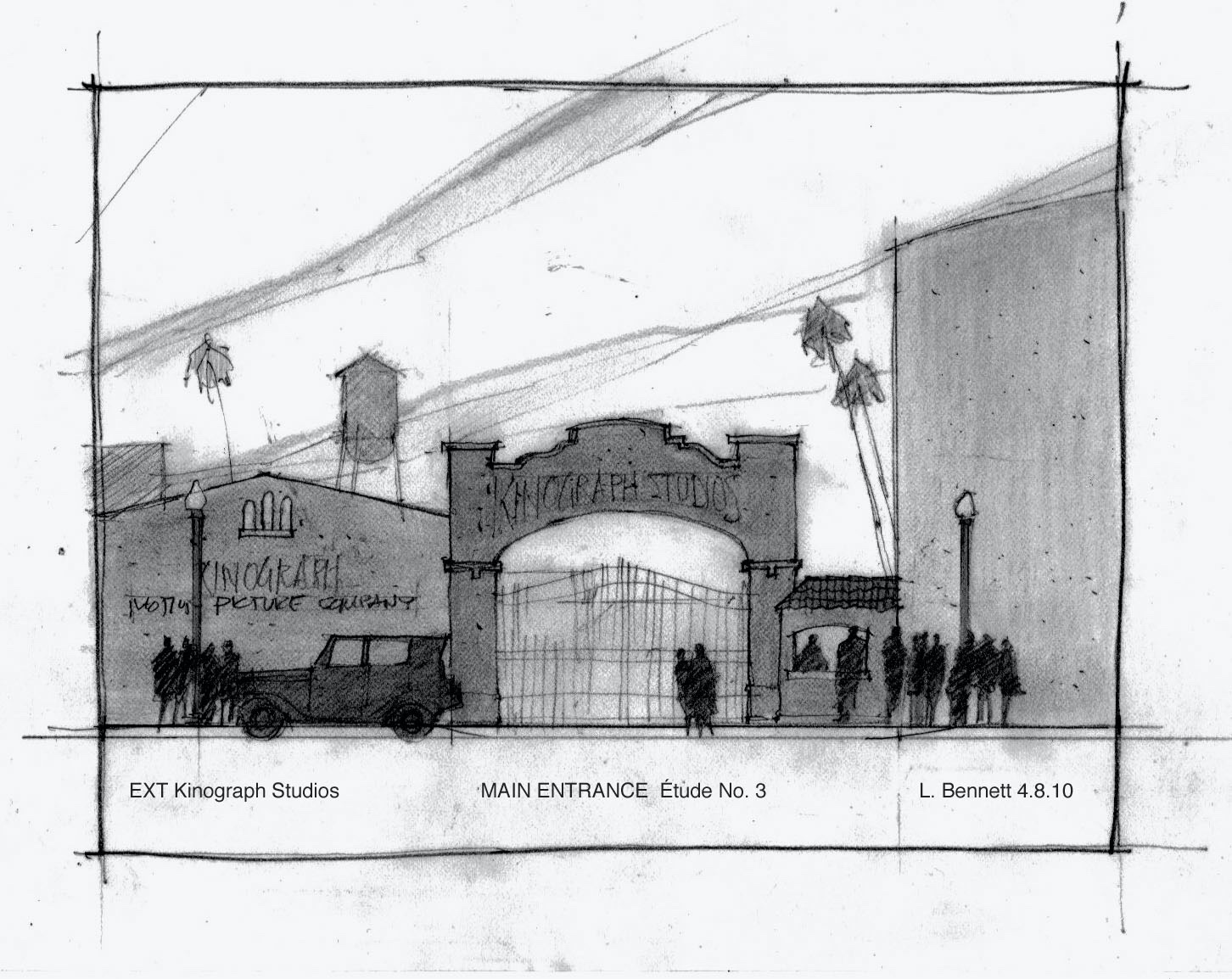
Exterior of Kinograph Studios, sketch by Laurence Bennett.
Kirill: What about the scene in the staircase as George and Peppy pass each other by as the studio moves to the sound productions?
Laurence: That’s a real beautiful historical building in downtown Los Angeles – the Bradbury Building, seen in many movies including “Blade Runner”.
Kirill: What’s next for you, besides the very hectic weeks leading to the Oscars? Do you think there’s a place for more productions of this type, or is it a one-off never to be repeated?
Laurence: I can’t really think much beyond that. Right now that’s keeping me pretty busy. I don’t think there’s going to be a big rush to make black-and-white silent movies [laughs]. What I hope is that there will be people willing to take chances to explore more off-mainstream approaches. I’ve been fortunate to have been involved in a couple of indies that really broke through, and when you’re working on something that could in fact be very special – but you’re not sure if anyone’s going to see it… Two pictures I’ve done – “Crash” and “The Artist” were different. When a small picture gets a chance to be seen so widely, and gets so much attention, it’s pretty remarkable the impact it can have.
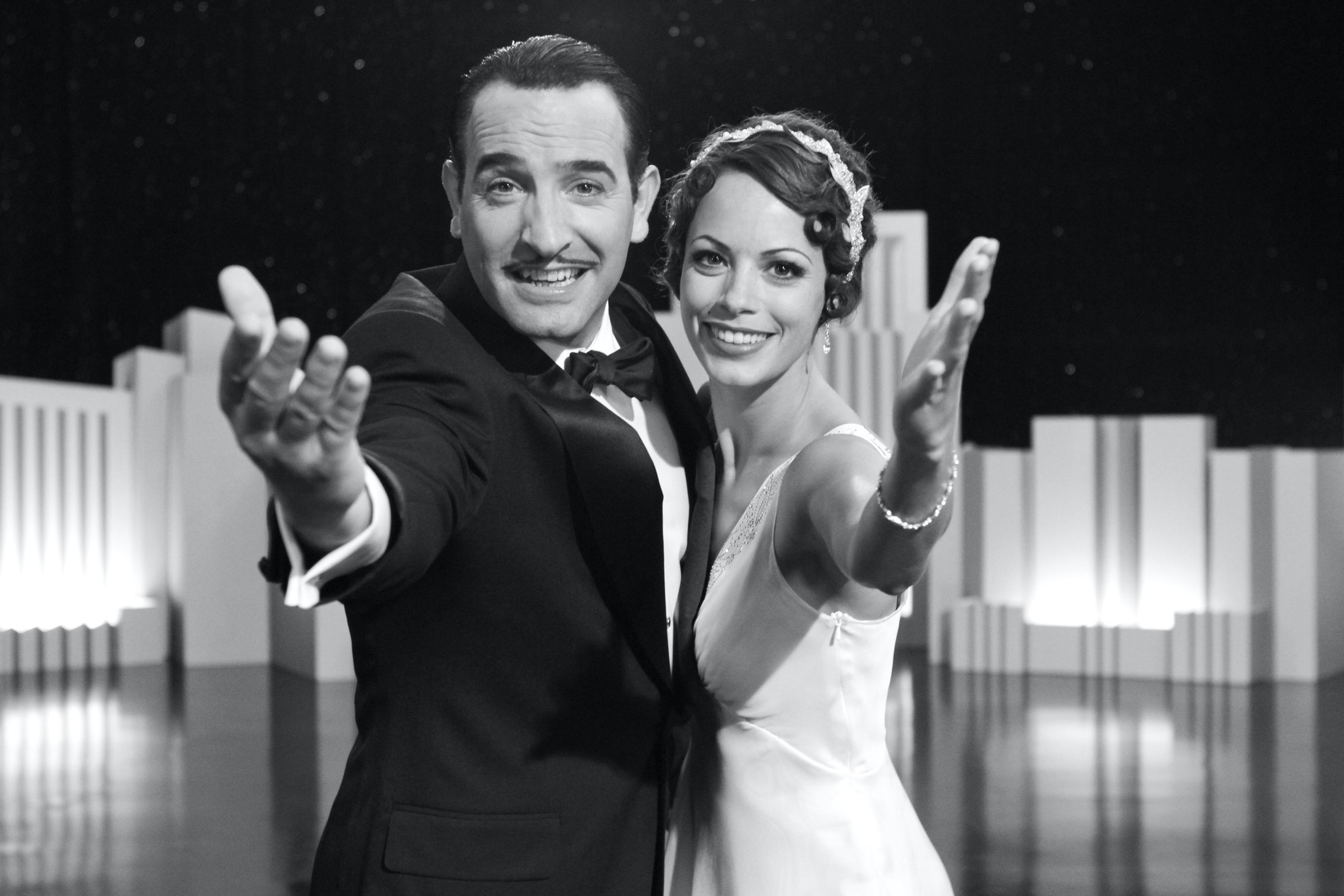
And here I’d like to thank Laurence Bennett once again for his work on this extraordinary film, for graciously agreeing to answer my questions and for sharing the materials used in this interview.
You may not see them on the screen, but their influence extends to every set and every scene in your favorite movies. In the last few years Katie Spencer took the role of set decorator on such wonderful productions as “Pride & Prejudice”, “Atonement”, “Miss Pettigrew Lives For A Day” and “Sherlock Holmes”. In this conversation she talks about the craft of set decoration, taking a closer look at the artistic and financial aspects of movie productions, supporting the main story while not drawing too much attention to the set objects and, in particular, her work on the movie “Hanna“.
Kirill: Tell us a little bit about yourself
Katie: I went to drama school in London in the early eighties to do the stage management and technical course. Then I worked in theatre for a few years, and while at The Royal Court Theatre I answered an advert in the UK “Stage” magazine for trainee buyers at the BBC. I trained as a freelancer at the BBC doing different buying jobs on a variety of programmes, and then transitioned from television into film, from buying into decorating as a natural progression.
Kirill: What is set decoration?
Katie: It is what you make of it. To me the most important thing always is the script, whether it came from a book, or an original screenplay the development of the characters within their environment is paramount. It’s all about the different characters. People may live in exactly the same time 2012 and be roughly of the same age, but they will never live in the exact same environment. To me, it’s making the written script come alive with the background, enhancing and not overshadowing. Set decoration is making the environment and the characterization work from t he script.
Kirill: Do you ever get scripts that go very deeply into describing the environment?
Katie: It’s very rarely that a film script would describe the environment in detail at all, unless it’s something very specific about a certain small prop that is essential to the narrative. Normally it would be along the lines of “He is a vicar, he lives in an 1880s vicarage, and needs to have a drawing room, a sitting room and a bedroom etc.” So there’s always a lot of freedom, which is lovely. Therefore you have to have an understanding of the character because there is little written in the way of stage directions of how this person would live. Unless it’s a big stunt sequence . Even careful storyboarding has little information about the background details.
Kirill: So within this freedom, how do you research the specific period?
Katie: If it was something that absolutely happened, then you have a duty to be as accurate as possible. like the Dunkirk beach sequence in “Atonement”, myself and the production designer Sarah Greenwood went to Dunkirk to see the town and its history for ourselves. Back in the UK we spoke to the veterans, and researched the war museums – portraying a story that is very near history comes with the responsibility to be authentic. And if it is “Sherlock Holmes” which is pure fiction, or “Hanna” which is contemporary, but fiction as well, you would still go to museums etc and the process is the same, you read, you get as much as you can from anywhere. Picture references are invariably the best type of research.

Kirill: Most of your movies are period productions. Do we get to see the original artifacts, or mostly replicas?
Katie: It’s nice to use authentic furniture, dressing and small props as much as possible, because there is something very exact about them as they bring their own histories and stories. Also you’re going to see them – a pen or a wallet – on the big screen in the cinema at ten times its real size, and authenticity then is invaluable. However sometimes they just don’t exist or aren’t available anymore and that’s when they become expensive prop makes. Or you have to or would want to make the furniture and drapes anyway because you can’t get them in the color or fabric scheme that you need. It’s a mixture. However it is nice to use as many authentic pieces as possible, and then bring in what you have made to further enhance the visuals.
Kirill: Does the complexity of your job scale with the overall budget of the movie?
Katie: It does to a certain extent. Obviously the bigger the budget, the more opportunity and scope there is. But sometimes when you have a smaller budget, it can be more complex and difficult because you don’t have that money to buy your way out of trouble, the “get out of jail” money as we call it. It’s always better to have money than not, but it doesn’t mean to say that the complexity is more. It’s very dependent on the film you’re making and there is never enough money no matter how much you have. It’s always tricky, always a difficult balance of money and time.
Kirill: Does it happen that you buy an item that caught your eye for an off chance to use it in your next productions?
Katie: You do sometimes, especially if you know that something is coming up when you don’t have so much money. So you buy it thinking that you can use it, but usually at the end of a tough shoot even things you loved at the time you just don’t want to see it again. You close the door on that and leave it behind you. I don’t have a store for things that I use again and again, just a few favorite items.
Kirill: Do actors sometimes bring family memorabilia?
Katie: I’ve never know that, and I would never advise anybody to bring anything of a sentimental value to a film set. Occasionally things go missing and the chances are that it will be that precious item that will get lost.
Kirill: After working on period productions, what was different for “Hanna” in the way of research, where we don’t have any special expectations apart from it being roughly modern?
Katie: I look at all films as set in their period. We’re living in a period now, and I think that modern is quite hard to do, and to do it well. The audience has much more knowledge, and you have to make them believe in the environment. When you’re doing something from 1780, not a lot of people are going to say “I wouldn’t do that”, but if it’s something set in 1980 onwards then they would. But from my point of view as a set decorator, I don’t live in a house that is completely 2012. I have a mixture of contemporary and some period items. So again it comes back to the character. We did “Hanna” and we also did a film in the States called “The Soloist” which was contemporary and was set on Skid Row in Los Angeles. The visual can be wherever you want to take it, apart from so many more computers, mobile phones etc in contemporary. It becomes more technical, which is great if you love that.

Kirill: Do you feel that you sometimes shape the viewers’ perspective about the specific era?
Katie: I think that if the film is done well, like “Dr Zhivago”by David Lean – that’s the first film I remember visually and I always thought that Russia was going to be like that, like an iced datcha. I think a good film does settle in your consciousness, and often it’s the visuals of it. You think “Japan must be like that because I saw it in this brilliant film.”
Kirill: Does it happen that you’re requested to draw inspiration from another production that the film director particularly likes, essentially extending the visual influence of that film?
Katie: That does happen, and it happened more in the early television days, when you’ve strived to have something out of the little you had. But now because of the Internet and because research is so much easier now where you don’t need to travel half a day to the photographic library, I think that people are more independent rather than trying to recreate the look we saw in a film before. It’s easier to find the references and new ideas.
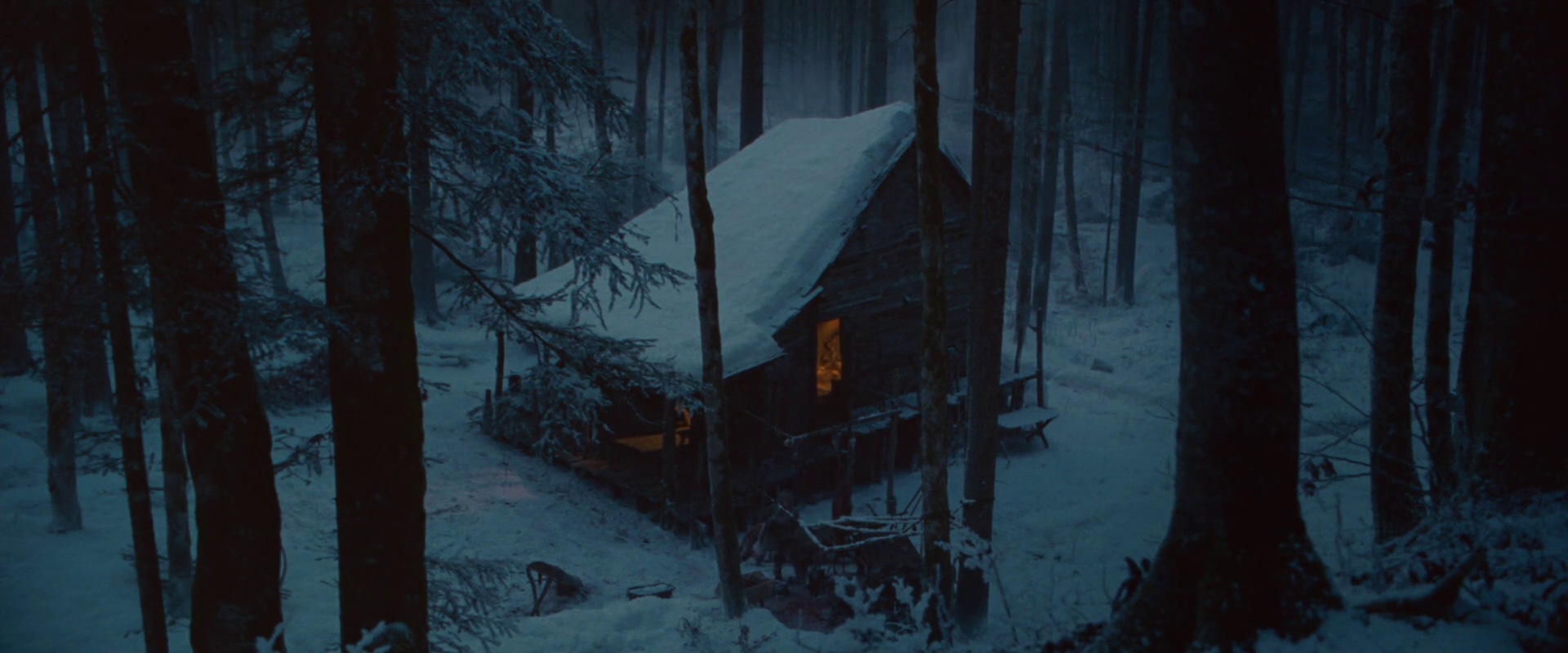
Kirill: Let’s talk about the specifics of “Hanna”. The opening sequence is the isolated environment, with vast spans of snowed forest in an abandoned winterland, going from the cold blue colors of the outside to warm golden amber yellows on the inside. How did you approach defining this look?
Katie: “Hanna” was a fascinating contemporary film to do because of her journey. There was a certain amount of rewriting in that script. To get to the starting base, you think about the whole arc and where she ends up. The cabin was the first thing we shot. And to get that cabin right, or as right as we could, to make her journey believable was quite tricky. First, we had to build it where we thought would be snow, and when there came time to shoot, there wasn’t enough snow. So we shot the opening sequence with the deer in Finland, as it was a very mild winter in Bavaria. There were many discussions about the look of the cabin, what it would be like, whether it would be more like an Inuit cabin or a teepee. And then we’ve realized that they had to have lived there for ten years at least, and you think how much they would have foraged from the outside. She couldn’t live in a sort of 20,000 BC world which is not modern at all, otherwise she couldn’t survive when she goes from it. So we decided that he [father] would forage and steal things from the local towns, and there is a mix of very simple and primitive, like cooking on a spit, sharpening stones and crossbows, but they also have a gun and books. Hanna had to have an understanding of the outside world. It was a fine line between being contemporary and really naive, but still believable to make it work for the action of the story.
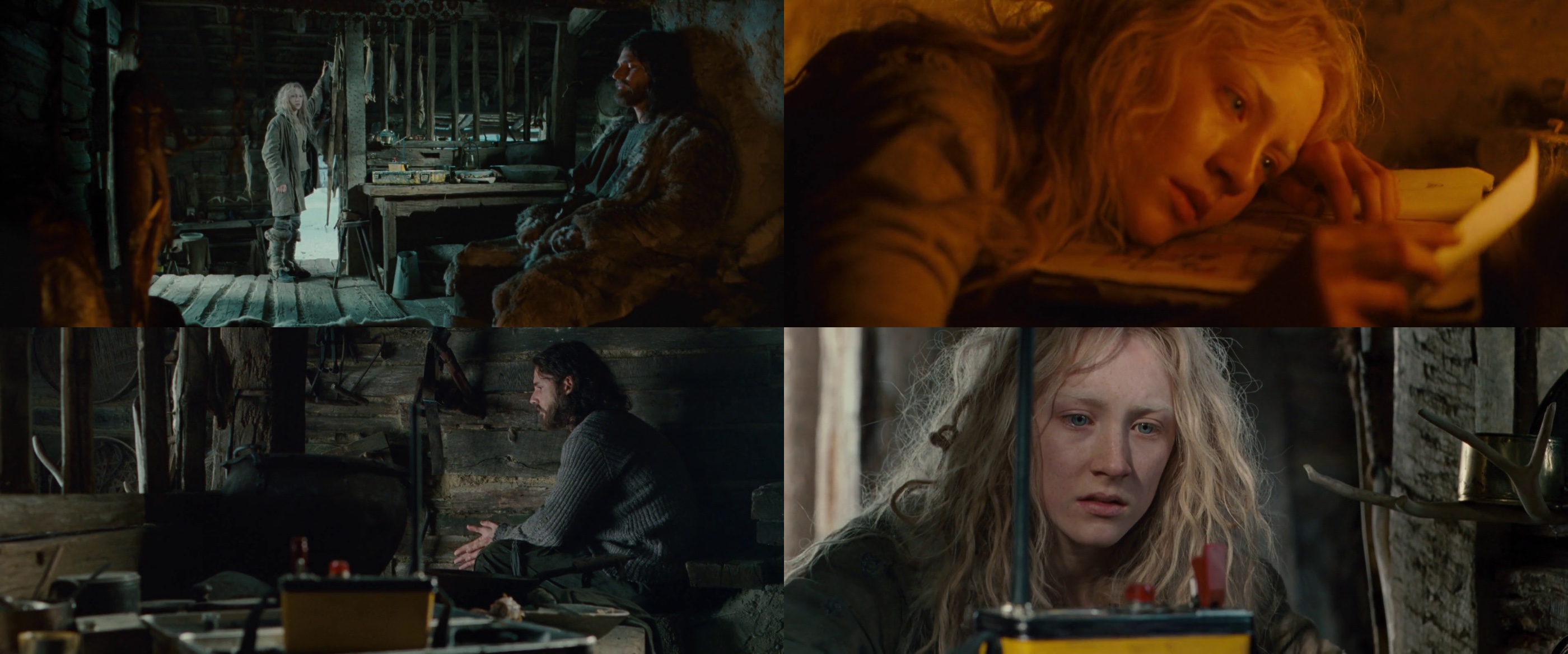
There was a lot of research into cabins from all over the world. Then we settled on a more traditional Northern European cabin and built it – as much as possible – in a naturalistic way. We made the candles to look like they came from the wax of the animals, made the characters reuse tin cans, construct their furniture from found objects and so on, it was really an interesting set to do. Quite tricky too, because you need the surprise of the modern era elements coming in, when Erik brings out the machine that alerts Marissa. Hopefully we’ve found that balance between her naive life, and not being too unknowing of the outside.
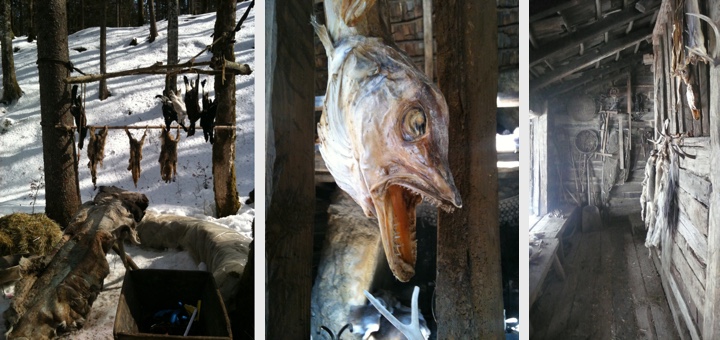
Exterior and interior set details. Courtesy of Katie Spencer.
Kirill: As you said, you’re planning the sets to serve the overall story. After being held in a very high-tech detention facility with very little control over the environment, Hanna next goes to a very primitive Moroccan hotel room. This was one of my favorite sequences, being very much set-driven with the appliances behaving like actors, springing to life and practically confronting her. What was the process of planning and shooting this sequence.
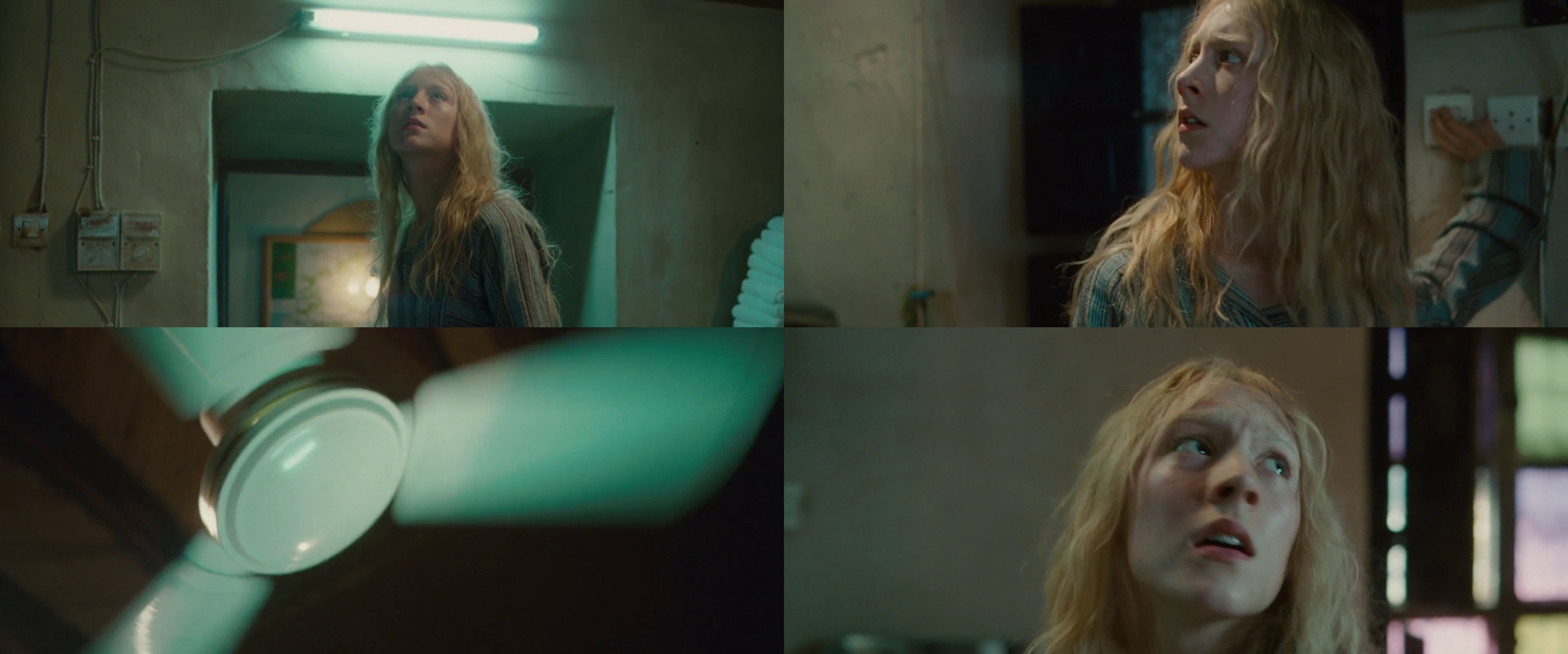
Katie: We actually did it in Morocco. It was adjacent to the hotel, a sort of an empty shed used to store old cars. The idea then became to keep it as a store room but have one of the spaces for people to sleep. It was written as hotel room, and that’s why it had a shower, a fan and a TV – coming on to frighten Hanna. Keeping these elements in but setting it in a store room made for difficulties. It worked and didn’t work. It worked for how the rest of the hotel played, but it was quite difficult to accomplish, to get all these objects in there and in there for a reason. Into this revised setting we had to create an environment for the caretaker and for Hanna, to make it a cross between the Arab world and the western world where everything comes alive to frighten Hanna. You don’t see so much of it in the movie, but part of the set was filled with product placement items that we got for free on a very tight budget. Orangina is this little bottle, it’s very African and it’s very European. And very orange and very odd, very Hanna.
So she had this little bed in the corner, and set decorating is very much about taking away and not only putting in, so sometimes you need to see very few things and that tells just as much of the story. Actually the wiring was so bad in Morocco, it was actually quite dangerous when the fan was turned on and the lights were going on and off. Saoirse Ronan is such a good actress and she can convey so much with her look, but it was very tense as it had its own inherent danger.

Kirill: Is the final movie close to the actual set? How much was changed in editing and post production?
Katie: We had very little time and money to do reshoots, so you see what is actually there. Paul Tothill is a great editor and Joe Wright is a very clever director. They have a gift of assembling it all brilliantly, as we didn’t have the leisure of extra time or extra money.
Kirill: How does your usual day go? Are you on the set as they shoot, making sure that things stay in place between the takes?
Katie: There are so many sets, quite often up to eighty. Therefore we’re often working ahead of the shooting crew. Say, at the first day on the Moroccan set we would see Joe [Wright] in, see the actors in, see the first take, make sure everybody’s happy. There is a standby art director on camera who is there all day every day with the shooting crew because we have to move on and do the next set. As nice, or as not nice to be with the shooting crew every day, we don’t have that luxury.

Kirill: Hanna goes through the different environments, from an isolated cabin to the high-tech detention facility to the Moroccan hotel to the “regular” apartment where her grandmother lived. And then suddenly she goes to an almost fantasy world of an abandoned amusement park, with the wonderfully designed Wilhelm Grimm house. Is this intentionally forcing her to the different facets of the outside world?
Katie: Sometimes you find a location that was not written in the script. We found this amusement park on the eastern side of Berlin, and it got rewritten into the script. We built a lot there, and it was the most phenomenally unusual place, last used around 1981. At the end “Hanna” was constantly being revised, mainly for budgetary reasons. There was a different ending at one point. There is this fairytale feel about it – to bring in this amusement park and the Wilhelm Grimm side of it. That was the case of a location leading the script. We built the Grimm house, we built certain things like the wolf’s mouth, and it just added to the whole fairytale element of Cate Blanchett being the wicked witch and Saoirse on her journey. It was great fun to do.

Kirill: Did you find this location before the shooting started?
Katie: It’s all before you start shooting. You have around 12-week prep where you’re researching. You have to have all the ideas before you start shooting. When you start shooting, the horse is out of the stable and you have to keep up just ahead of the shooting crew. Sarah [Greenwood] the production designer goes on provisional scouts with the location manager, and I would often go with her. After the provisional scouts the director would then join to be shown what locations have been found. We scouted different places, for all the different possibilities of the script that wasn’t quite finalized. And this is when we came upon this abandoned amusement park and it was just so visual that it was impossible not to use it.
Kirill: What happened to that Grimm house that you’ve built?
Katie: There was some debate about it. There was some legal problem with the amusement park about who owned it, and the history of bankruptcy. The person who owned it wanted to keep it, as it was good thing for him as ideally he would’ve liked to open the park again, but the reason why it failed to begin with was because it didn’t supply any car parking and there was no train station in the vicinity. Once the Berlin wall came down, it was a whole different ballgame anyway. He wanted to keep the house, but there health and safety issues – which are everywhere. We had built it as a film set. It wasn’t safe enough for an amusement. So I believe it was taken down, but there were still discussions as we were leaving Germany. But normally all the sets are taken down, and very few are kept.
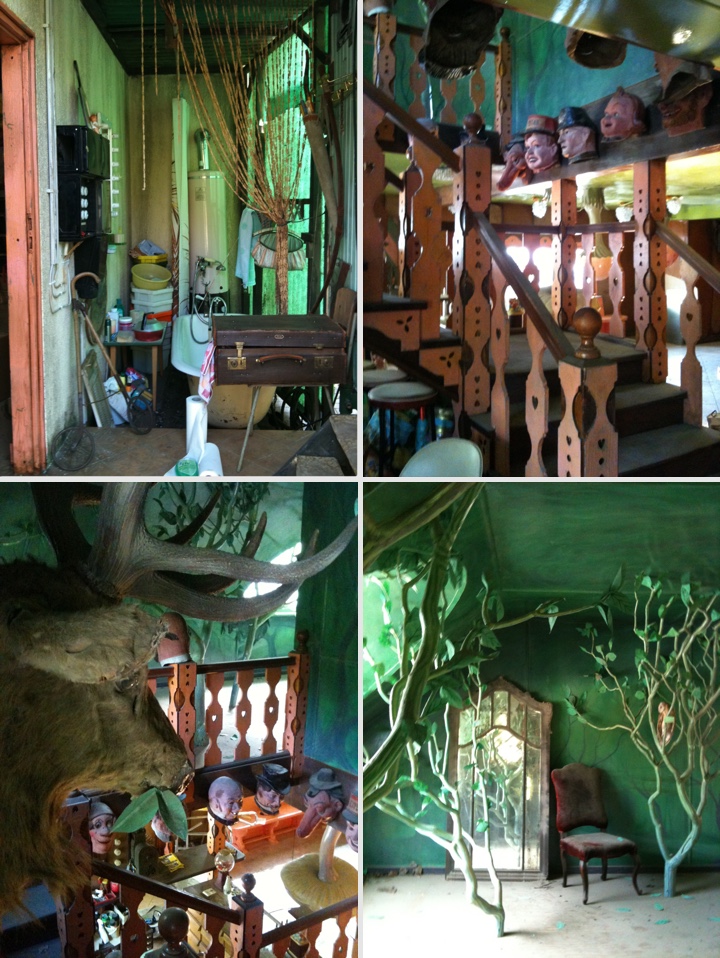
Various parts of the Wilhelm Grimm house set. Courtesy of Katie Spencer.
Kirill: Where did you spend the most time on this movie?
Katie: The cabin was tricky. Morocco was tricky, especially logistically. We did this camel market where Hanna walks through on her way to the hotel. We were in a dry riverbed, we had dressed the market, berber tents, stalls everything. Now we were waiting for the 200 camels garnered from 100s of miles around all of which had to be walked in, because there was no transport. Sometimes you feel very lucky to be doing what you’re doing. You travel, and it can be stressful, but I will always remember that early morning as I was thinking whether the camels were going to arrive, will we get only six of them, and they will be shooting in a couple of hours, and then suddenly over the hill came these scrawny animals – working camels, not tourist camels. It was one of the most remarkable experiences of my life as the sun came up and all these camels, two hundred camels coming over the hills our way. It was wonderful.

So logistically even when there are no walls on the set it is quite tricky. The Wilhelm Grimm house wasn’t that tricky. In a way you had a template there with the amusement park, so it wasn’t the hardest. Sometimes what seems to be the simplest sets are the hardest to do. Cate Blanchett’s apartment – because we couldn’t find the right location for Marissa (finding America in East Berlin) and we wanted to keep it as bleak and neutral as possible. Things that you don’t think will be simple end up being difficult, and things that people go “Wow” were actually quite fun to put together. You can never tell.
Kirill: After “Hanna” you worked on the second installment of “Sherlock Holmes” and now on “Anna Karenina”. As you said everything is a period production, but you are going back to earlier periods. Is there any special treatment to sequels where you want to maintain some visual continuity?
Katie: It again goes back to the script. With “Sherlock” he is still living in the same house, so of course we had to redo it. For the first movie we built the interior of Sherlock’s house on Baker street in New York, because Robert Downey Jnr needed to be in New York. Now we had to recreate it and build it here in the studios in London. You follow the script, and the script for “Sherlock Holmes” is always completely bonkers and is always being revised by Robert, Jude [Law] and Guy [Ritchie] with a lot of improvisation. In this script he turned the apartment into a jungle and you think “How is that going to work, what do you mean it’s a jungle in there?” That’s difficult to do, because you don’t want it to look like as a period house with a few rubber plants in. We also had many sets built that were meant to be in Paris or Germany, and a chase across Europe. Doing “Sherlock Holmes” is not like doing any other film because you get a very free hand which is lovely, but you are never quite sure what will come out of the rewrites. But it’s fun and entertaining.
Kirill: Do you tweak the production and visual aspects on the look of the specific actors, things like skin tone or physical frame?
Katie: It does. Skin tone affects the colors of the walls and similar things. Physical frame is an interesting thing. If you’re doing Gollum’s house, you design it around what Gollum is. And to another extreme of Father Christmas’s house, it would have the matching aspect. It does manifest how they carry themselves and what they look like. It’s really important to see who’s playing the parts. Quite often the supporting cast comes in after the major casting is done, and you need to know whether Marissa in “Hanna” is going to be Cate Blanchett or Judy Dench. It puts a whole different slant on how they would live and what they would wear. Costumes are very important, because what you wear is often reflected in how you live.

Kirill: Do you think that actors bring certain visual heritage from their previous movies? For example you worked with Keira Knightley on “Pride & Prejudice”, “Atonement” and now “Anna Karenina”, and she’s in a lot of period movies – do you expect the audience to expect her to look in a certain way?
Katie: Keira is quite a good point, because she does do a lot of period films. She’s been asked many times about this, and she’s said it’s because of better scripts. We’re not quite finished with “Anna Karenina” and we’re actually going to Russia at the end of the month to do more shooting, chasing the snow again. So you know you’re doing the beautiful Anna Karenina and then you talk to makeup to find out she’s going to be slightly different, also being older than Vronsky is another interesting aspect. Having worked with Keira you also know how she works within sets and that’s really helpful. Robert Downey Jnr is very interested in how his character lives, more than anybody else, I think. He’s very methody in that way, and he would take something from the Baker street set and use it as one of his continuity props. Knowing that made “Sherlock Holmes 2” a little easier since I knew how he works.
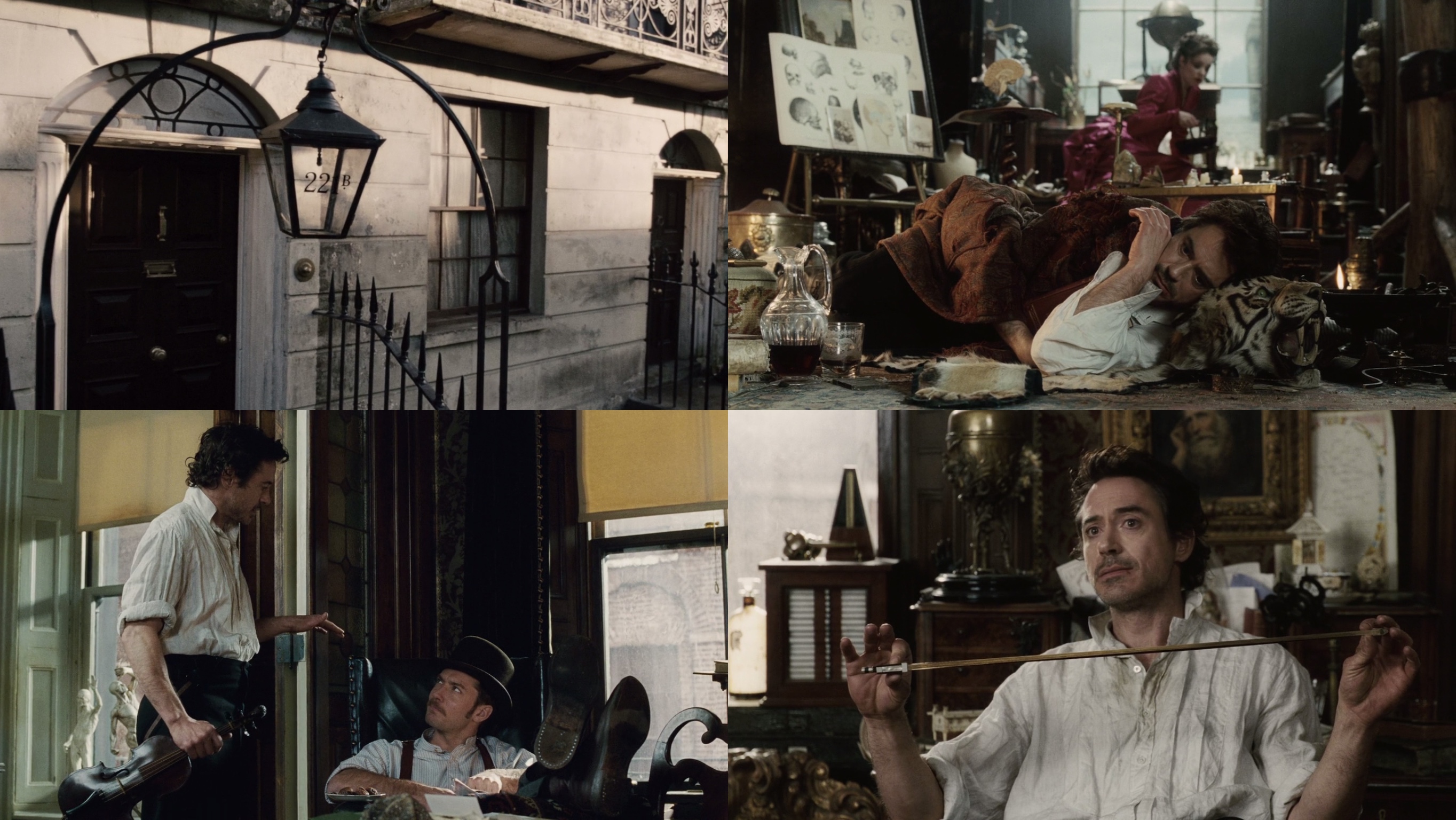
Kirill: Going back to Gollum, he is not a real physical character, but rather motion capture further enhanced and brought to life in an advanced computer-generated environment. Do you see virtual set creation and manipulation encroaching on your turf, being something that you adapt to and help shaping?
Katie: I think that if it continues that way, it will encroach on everybody’s turf. I think it will be the hardest for art directors as opposed to production designers because they will always have the overall view of the look and visual effects. It will still affect set decoration, but as the actors still have to interact with their immediate environment hopefully there will employment for us. There’s a place for it and it’s absolutely fabulous when it works well. When CGI and non-CGI melt together you get a brilliant effect, but it can also be overused. I think that teenagers especially get bored of CGI if it’s not done well. If you would’ve said this to me years ago, i would’ve thought that CGI would come further and there’d be more CGI films – like “Sky Captain and the World of Tomorrow”. Perhaps because we’re going through a period of recession it seems to be more nostalgic coming back to more traditional film making. If I was offered a completely CGI film to do, and a normal film, I would go for a normal film.
When it does work as a set extension, enhancing sets on a traditional film, it’s brilliant. But you shouldn’t be aware that there’s CGI anywhere. You shouldn’t know where one ends and another begins. You shouldn’t lose the magic of it actually being done in camera.
Kirill: Did you do any set augmentation in the second installment of “Sherlock Holmes”?
Katie: We did the exteriors of Baker street in London, we build a Paris cafe with the Eiffel Tower behind. This is where CGI is nowadays in period films – cityscapes. We had brilliant people doing CGI and it works well. It was the most CGI of any of my films, and it’s just the nature of this film really.
Kirill: Are there any particular productions that influenced or impressed you over the years?
Katie: If you see any Coen brothers film, you just know it’s going to be beautifully realized for the story, for the character, for whatever period it is set in. I also love Ang Lee films, and he takes real challenges going between one and the other in different genres. You can’t not look at the sets, and you recognize different things. And now we’re in the middle of the voting season [Oscars], and with all the DVDs you just forget and get mesmerized by something – that’s the best thing of all, really, when you’re just a viewer. I love all films, the 40s, the 30s, and some silent films. They’re visually stunning.
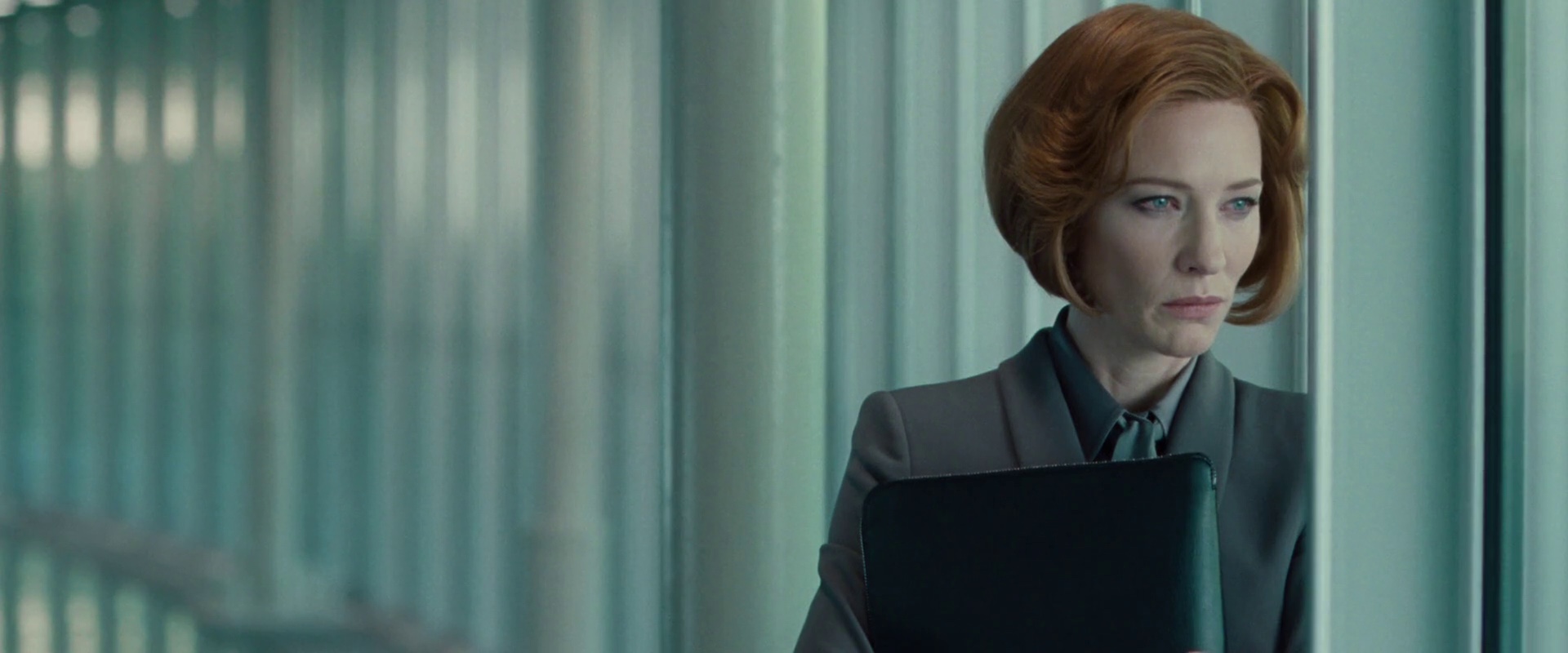
And here I’d like to thank Katie Spencer for finding time in her busy schedule shooting Anna Karenina to talk with me about her work. Her latest movie, “Sherlock Holmes: A Game Of Shadows” is playing in the theaters, and she’s in the middle of shooting “Anna Karenina” which continues her collaboration with actors Jude Law and Keira Knightley, production designer Sarah Greenwood, art director Nick Gottschalk and supervising art director Niall Moroney. Also, special thanks to Sarah Horton for putting me in touch with Katie.
![]() That was how it began for me, and I was extremely lucky that the director of that film had gone to NYU with Ryan Fleck and Anna Boden who directed “Half Nelson”. About two or three years after I had done that first film, Ryan and Anna called to see if I would be interested in doing “Half Nelson” which will forever be the film that really began my career.
That was how it began for me, and I was extremely lucky that the director of that film had gone to NYU with Ryan Fleck and Anna Boden who directed “Half Nelson”. About two or three years after I had done that first film, Ryan and Anna called to see if I would be interested in doing “Half Nelson” which will forever be the film that really began my career.![]()
![]()
![]()
![]()
![]()
![]()
![]()
![]()
![]()
![]()
![]()
![]()
![]()
![]()
![]()
![]()
![]()
![]()
![]()
![]()
![]()
![]()